watchsPROLOGUE
“I’m sorry, but is this real?”
A few weeks ago, I was emailed to say that I’d been selected as a finalist for the 2019 Thailand Village Academy, a programme designed to equip young storytellers from around the world to share authentic experiences from some of Thailand’s most amazing villages.
First of all, I’m thrilled that I’m still considered to be young (OK, so I scraped in by a few months, but hey, I’ll take it!), but also…pinch me! Because yes, the programme is real, and as I type this, I’m in my hotel room in Bangkok preparing for the adventure of a lifetime. There are 44 of us in total, heading to 22 different villages to enjoy countless experiences. We’re all excited. We’re all nervous. We all have matching blue T-shirts.
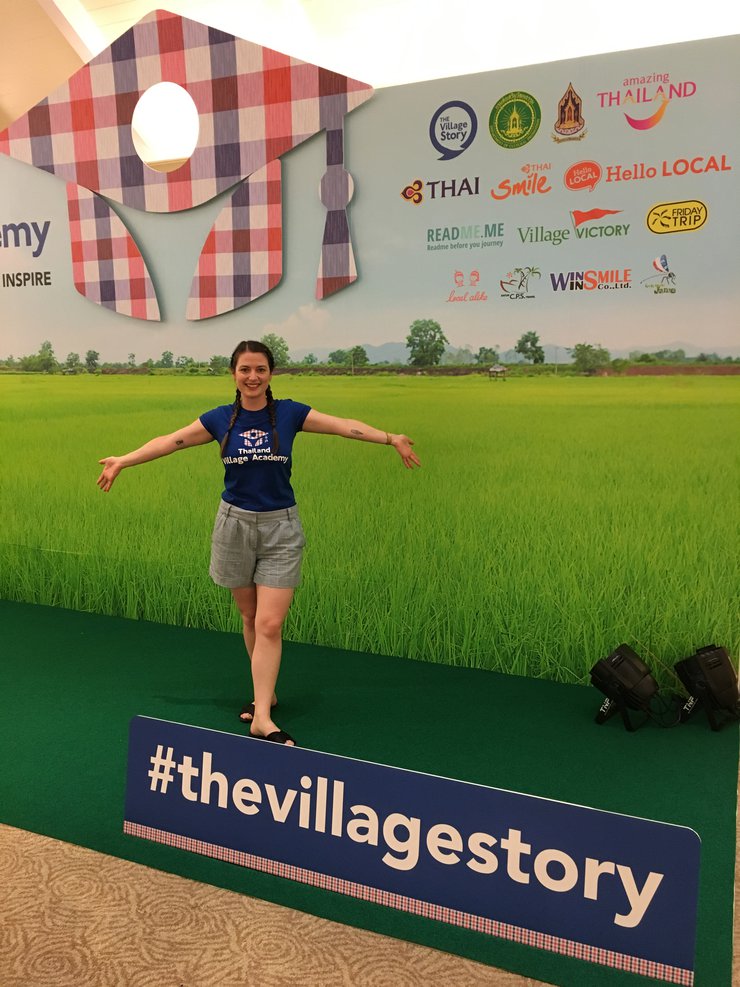
Excited to begin my Thailand Village Academy adventure
I’ve been wanting to come to Thailand for years. Whenever I say I haven’t been, people look at me like I’m crazy which, OK, maybe I am, but for one reason or another, I’ve never made it here. I think part of it is because loads of people have told me that the Thailand they visited years ago doesn’t really exist any more. The beaches that were once isolated and unknown are now packed with visitors, and it’s harder to find authentic, local experiences.
That’s why I’m so excited to be taking part in Thailand Village Academy.
For the next 6 days (starting in just a few hours), I’ll be spending time in the community of Ban Bang Phlap, in Samut Songkhram, just an hour or so outside of Bangkok. Paired with a Thai National storyteller, I’ll be welcomed into the community and will get to see a side of Thailand I never expected to see: authentic, untouched. Local.
There will be train markets and floating markets, monks and monkeys, mangroves and coconut orchards, cooking and kite making, trains and ferries, temples and clam digging and even a salt farm, and I can’t wait for each and every moment of it.
I’ll be documenting every day of my journey (internet permitting) right here on Readme.me, so please do join me on my journey as I share a new perspective of a country that still holds so many surprises!
DAY ONE
Day one starts with a taxi ride from our hotel to Wongwian Yai Railway Station, in what feels like the centre of Bangkok (but I don’t have my bearings, so it really could be anywhere!).
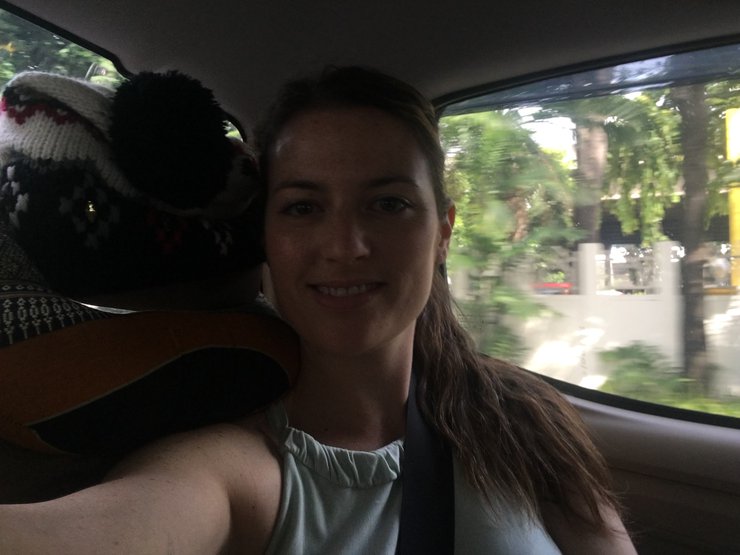
In the taxi and ready for adventure!
For the whole cab journey, I am glued to the window, watching the skyline unfold ahead of me, marvelling at the scale of it. Bangkok's skyscrapers make London look like a toy town!
Life is unfolding everywhere I look. There’s the man sleeping in the back of a truck, the women sitting side-saddle on the back of motorbikes, on their morning commute, and the guy on his tea break, sitting beside a highway staring at a pond filled with water lilies. Seeing him is a timely reminder to look for beauty even in the midst of chaos.
We arrive at the station, which is little more than a line of chairs and shops along the railway track, motorbikes and pedestrians and cyclists all hustling past, excited chatter mixed with the unhurried silence of passers-by. My guide, who speaks but a few words of English, has disappeared somewhere, leaving me with a gaggle of suitcases. It's hot and sticky, although the locals are all in trousers and even cardigans. My comfort zone is something of a speck on the horizon behind me at this stage, but I’m trying to take it all in, to just go with the flow (something I know I need to work on)!
The train trundles through the city, nothing gentle or smooth about the rumbling, jolting, humming it creates as it traverses homes, roads, fields and tiny, stagnant streams.
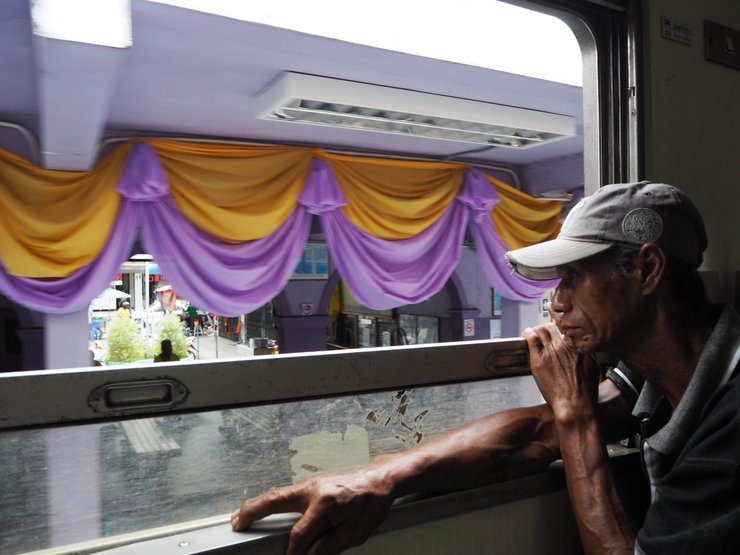
Passenger on the train
Fans oscillate lazily from the ceiling, but the wind is doing a better job of cooling me as it sweeps through my hair, my eyes glued to the view. Lush green covers everything. There are waxy thick leaves of the banana plants, gentle fronds, long verdant grasses, lilies, and every other size and shape and shade of green, growing in and from and through every space I see. Shrines peek out above fences and through gaps between buildings. And, as a slight aside, I will never complain about a British train toilet again.
We step off the train at Mahachai Railway Station - after about an hour of travel - directly into a crowded market. The smells are overpowering, fish and fruit and I have no idea what else. I pull my suitcase, dodging people and cars and vans and bikes and tuk tuks, fish heads glistening to my left and right, bags of bright orange, crunchy dried shrimp perched on stall countertops.
We lose our guide - again, but only briefly - and decide to wait for her at Tha Chalom Pier, where motorbikes and mopeds pile into a tiny green ferry. We walk down the rickety metal gang plank onto the boat, which leaves the dock with a groan and a churn. It's a quick journey across the Mae Klong River, and soon we're bumping against the opposite bank, a giant gold Buddha visible through the trees. There’s another market, here. Smaller, pressed along the edges of the street. There's a school, a temple, a tourist information centre, a cafe, and another train station.
We sit, sweaty and tired from lugging our bags, and spot the timetable. We have an hour's wait before the train from Ban Laem Railway Station to Maeklong Station. Other passengers pass the time by laying on the benches, or buying small bags of food sold by the vendors along the tracks.
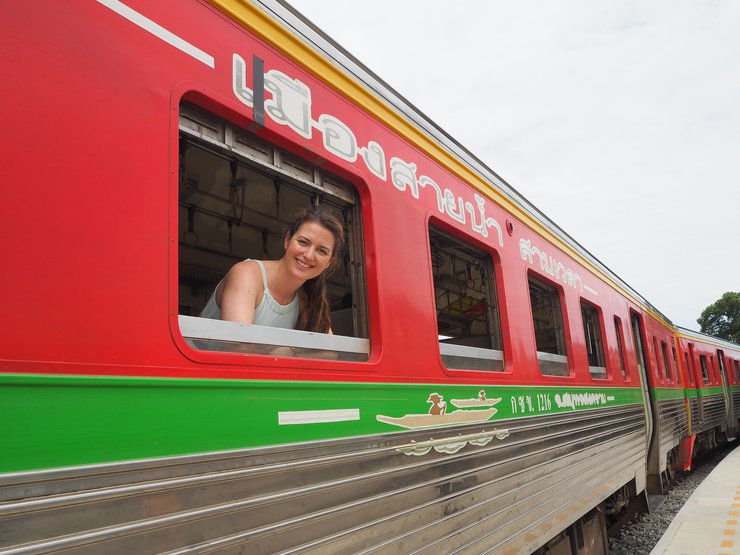
At Maeklong Station
We try to make conversation. Mulan, our guide, takes photo after photo of us in various awkward poses. My Thai buddy Q and I try to chat in stuttered words and sign language and, occasionally, Google Translate. He knows a few words in English. I know exactly two in Thai (hello and thank you) so it's not exactly sparkling conversation. And yet we chat — verbal or not, it all counts — about editing, about Mulan and her love of taking photos. About the heat.
The train arrives. We pose for more photos (some of them our own this time), and hop on board. As we begin to move, the sun beating down on our skin, the carriage rocking not so gently back and forth, my eyelids begin to droop.
I’m woken by splashes of rain on my arms. It’s lashing down suddenly, monsoon season well and truly in full swing. Soon we reach Maeklong Station, the train only just squeezing past the crowds taking photos and the awning of the market stalls.
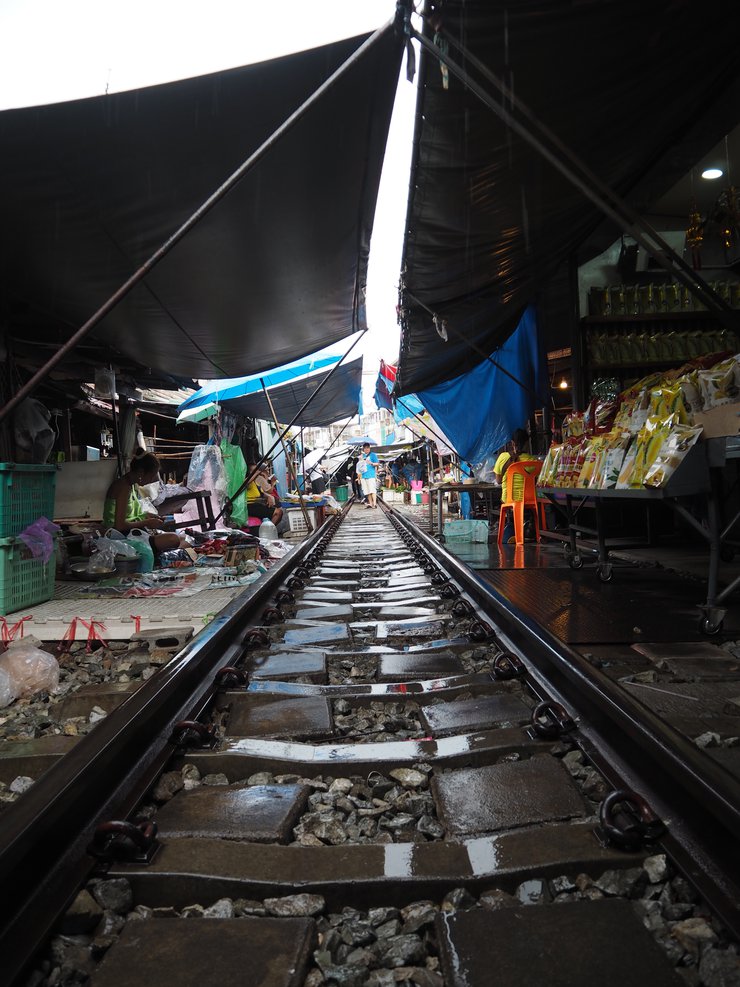
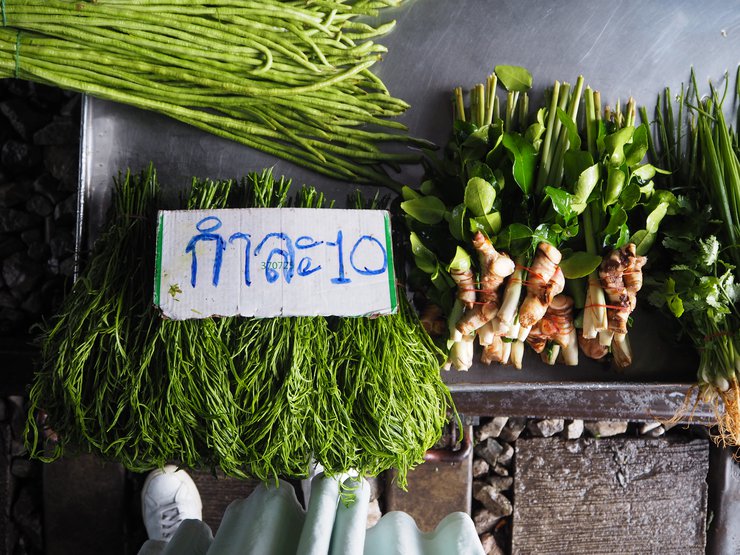 Fresh food at Rom Hoop Market
Fresh food at Rom Hoop Market
This is a market I’ve known about, and wanted to visit, for years. But it’s going to be a while before the train starts moving again, so we sit in a small restaurant called Gong Meng Chan and enjoy wonton noodle soup, and Thai iced coffee, which is incredibly sweet and just what I need in the heat!
Soon it’s time to hustle through the market, stepping along the train tracks, under dripping awnings in primary colours, past vegetables and clothes and fish and dried fruit. A bell from the station sounds, and the vendors begin covering their wares. They’re not in a hurry, but it’s clear that they’ve done this so many times before that they barely need to think about it.
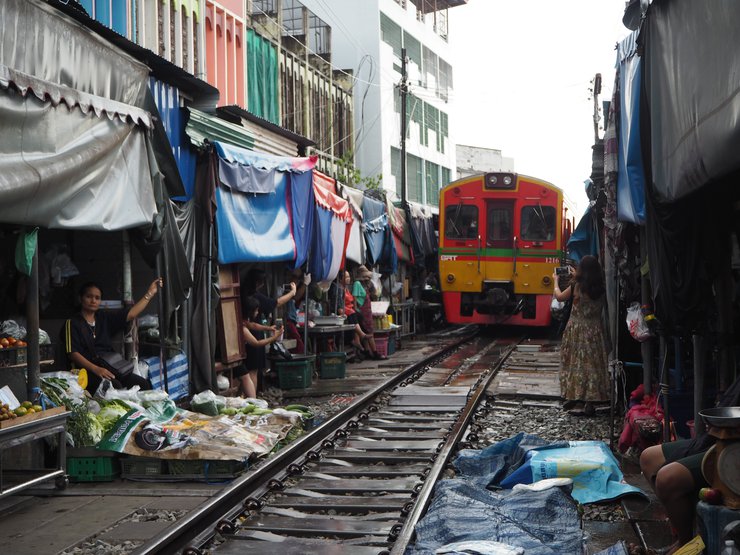 The train approaching
The train approaching
I watch, excitement building, as the tracks are cleared. A bell rings again. There’s a ripple of anticipation among those who have come to watch the famous spectacle of Rom Hoop (“folding umbrella”) Market. The train appears from around the corner. It’s not coming quickly, but it’s so close that I could reach out and touch it. I don’t. Instead I watch in awe at this perfectly measured performance. A few centimetres difference, and a whole stall could come tumbling down.
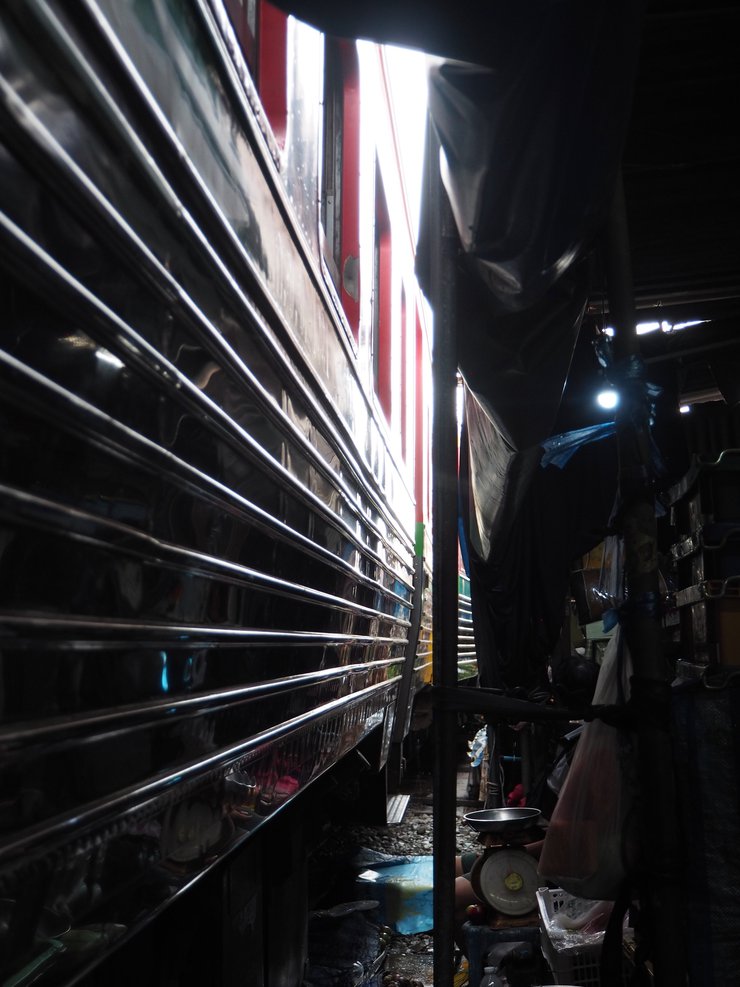 So close I could have touched it!
So close I could have touched it!
As soon as the train sweeps past us, the awnings are put up again, and within seconds, it’s as though nothing out of the ordinary happened. It’s every bit as wonderful as I hoped.
 The train still in sight, vendors put their umbrellas back up
The train still in sight, vendors put their umbrellas back up
We meet our local hero, Tong, from Ban Bang Phlap Community, who drives us to the Ban Suan Saeng Tawan homestay, a simple set of rooms surrounded by tranquil fruit orchards. There’s barely a sound out here.
We are treated to a delicious meal of crab omelette, Tom Yum chicken and fried shrimp with broccoli, and then it’s time for bed. We’re all tired after so much excitement, and there’s SO much more to come tomorrow…
Advertisement
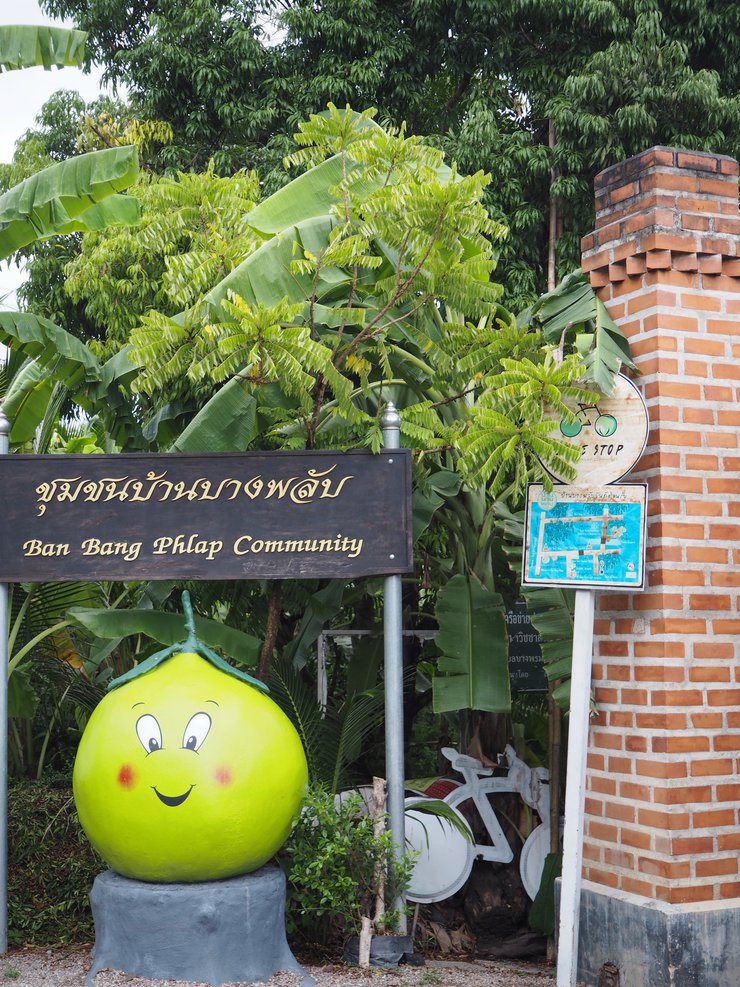
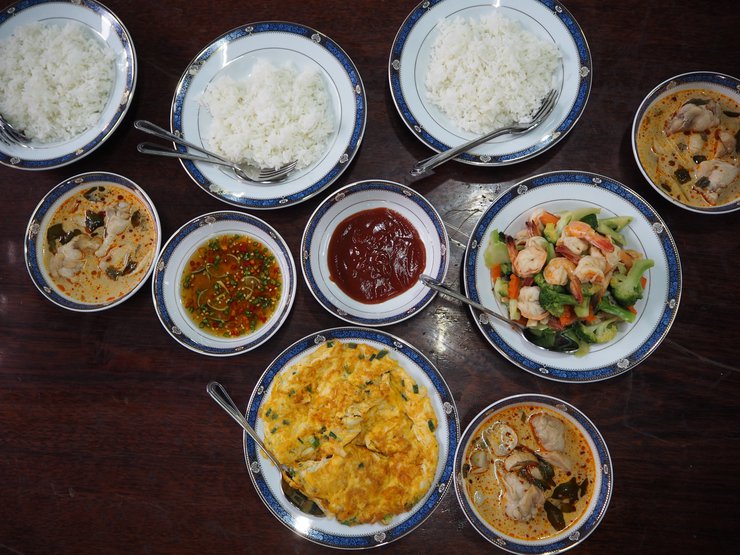
A very welcome dinner!
DAY TWO
My alarm goes off at 5:20am, a time I admit I don't usually see.
After a quick shower, I dress for the day and stroll out in the heat to the front of our homestay, where a table is set up right on the edge of the road. On the table is a bowl containing parcels of food and beautiful orchid arrangements, as well as a pot of rice.Within minutes, the monks arrive. There are three of them with shaved heads, ensconced in orange robes, all walking barefoot through the village to receive their daily alms.

A monk after receiving his alms
Monks aren't allowed to possess money, so their communities provide for them by way of food each day, and today they stop with us.
I'm not entirely sure of the protocol, so I just observe quietly as the monks open their almsbowls, and they are slowly and carefully filled with rice, pouches of what might be curry, floral arrangements and bottles of water. Suddenly everyone is taking their shoes off and putting their hands together in front of their faces, so I do the same. We are blessed by the monks before they continue down the road.
It's all over in a couple of minutes, but it is a humbling moment, and a reminder of how beautiful it is to see community spirit demonstrated in such a tangible way.
After breakfast, we sit inside the community centre and Somsong Saengtawan, the president of Ban Bang Phlap Community, gives us an overview of the region's famous organic pomelo farming (it really is famous - it has the awards to prove it). One example of how they innovate in their farming, which really jumps out at me, is their use of salt byproducts.
As well as pomelos and coconuts, Samut Songkhram is known for salt production, with salt farms taking water from the nearby sea. When the salt is collected from the top of these fields, there's a substance underneath which the salt farmers usually throw away. However, due to its high potassium content, it's perfect to use as fertiliser for the pomelos, as it makes them so much sweeter. Communities in this region work together, finding natural solutions and greatly reducing waste.
Immediately after the presentation, we're led outside to watch (and help with) the creation of coconut sugar, using nectar from the coconut flower.
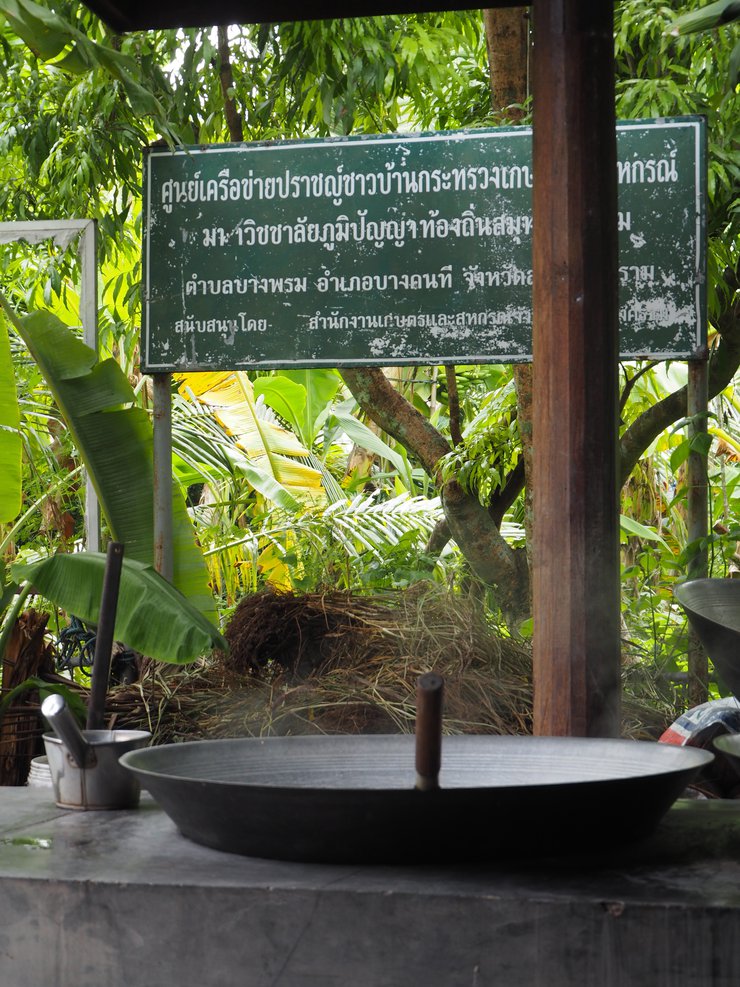
"stove" for reducing coconut nectar
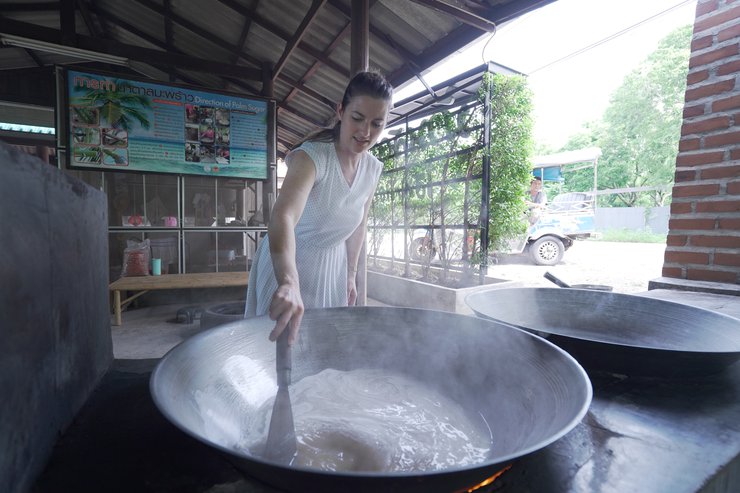
Stirring the boiling coconut nectar. It's so HOT!
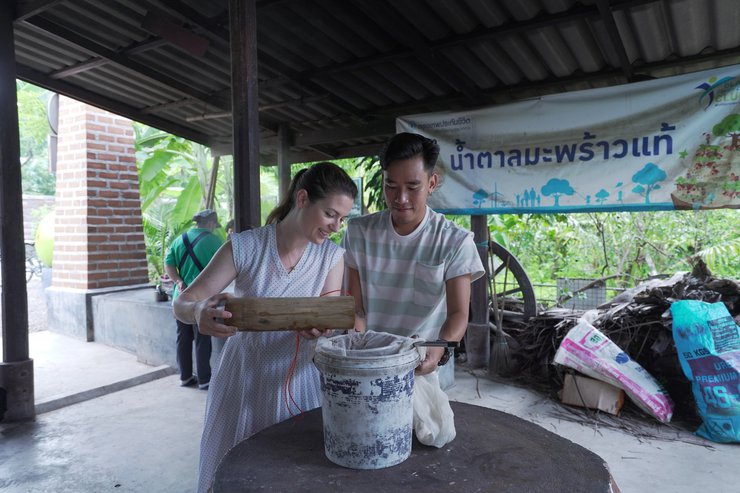
Straining fresh coconut nectar that's been collected from the flower
I didn't know what a coconut flower looked like until today, but it turns out it's a bit like a tap: it protrudes from the tree and, when the end is cut, nectar pours from it for about a month.
This nectar is collected twice a day, and then heated in huge pans over a fire until it's reduced down to a thick, caramel-like texture. This involves mixing, skimming, swirling, and a whole lot of sweating, but it's amazing to watch, and loads of fun to take part in. Watch my video to see what this process looks like!

The frothing, boiled nectar right after being taken off the heat
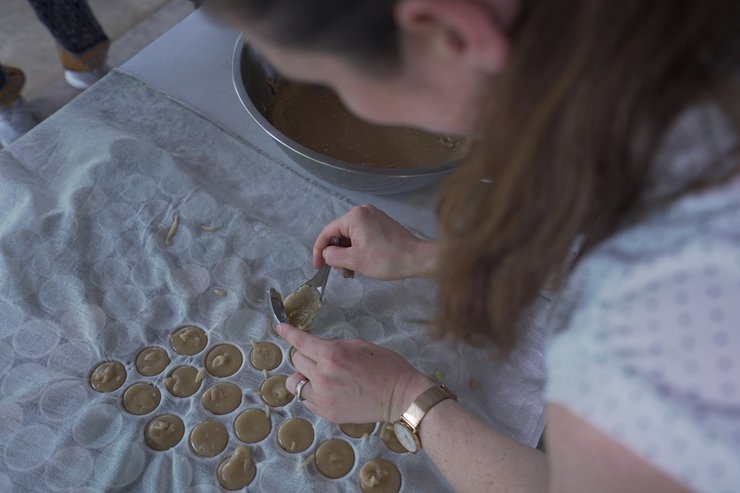
Scooping liquid sugar into moulds
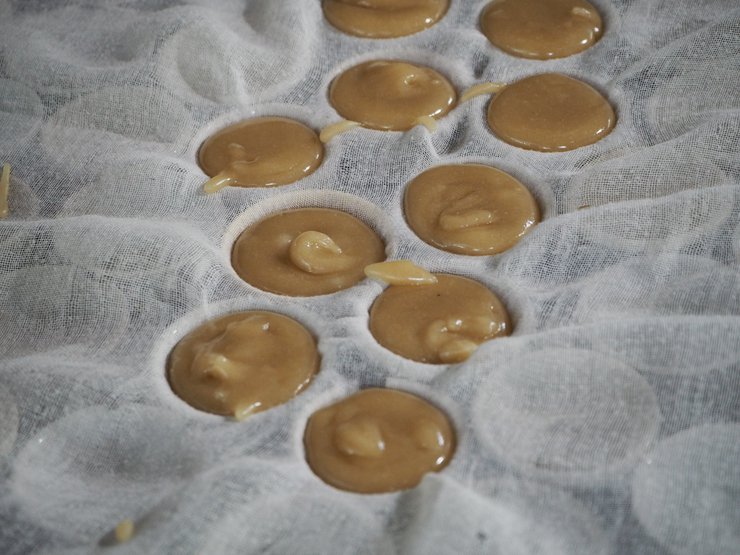
Waiting to cool (the muslin makes them easy to remove & package)
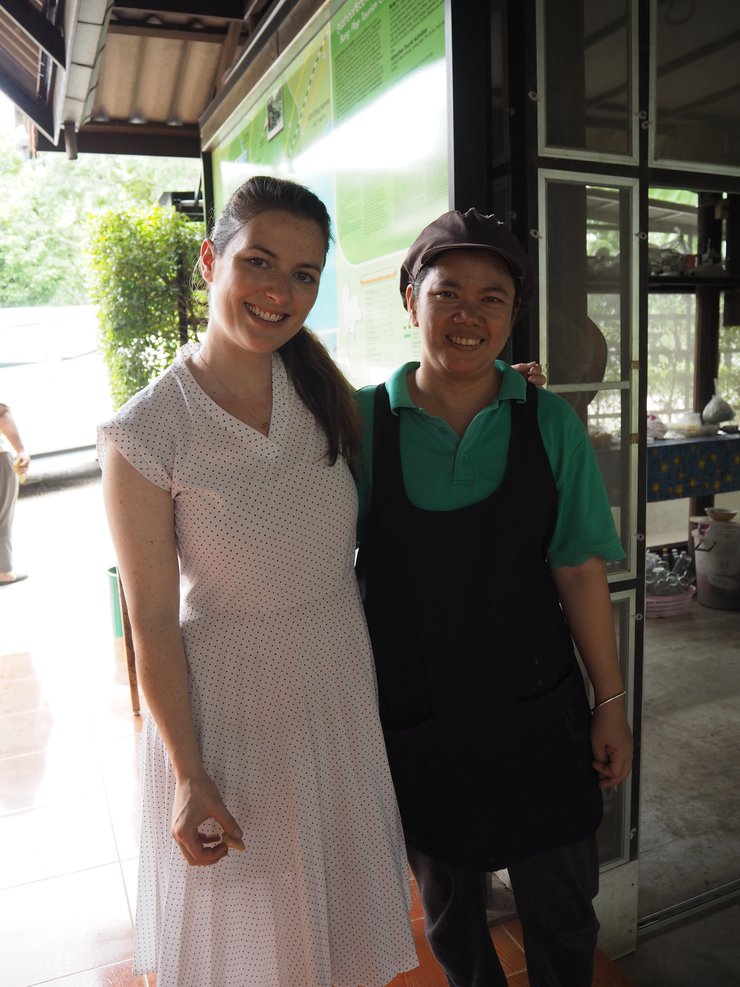
With the beautiful woman who makes this sugar every day
After this, we get on bicycles (there are plenty to borrow here at the community centre) and ride into the pomelo orchard.
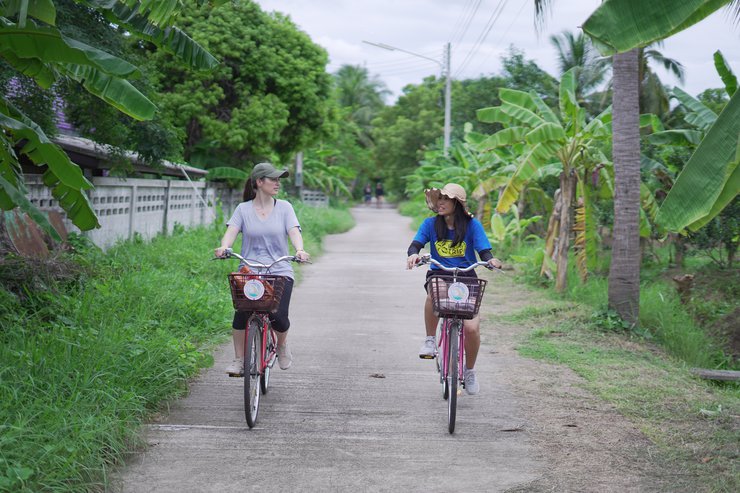
Riding with my guide, Lucky
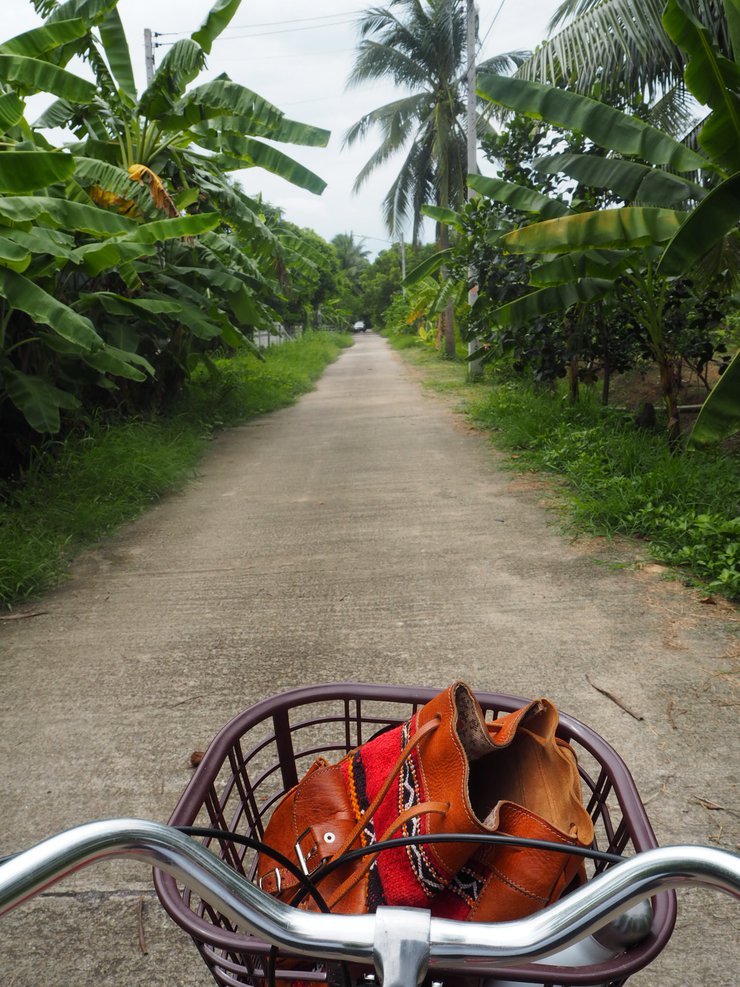
The bike route around Ban Bang Phlap
Here we meet Somsong again, and he shows us how new pomelo trees are created by tricking branches into growing roots and then cutting the branch to re-plant.

Freshly cut pomelo cutting
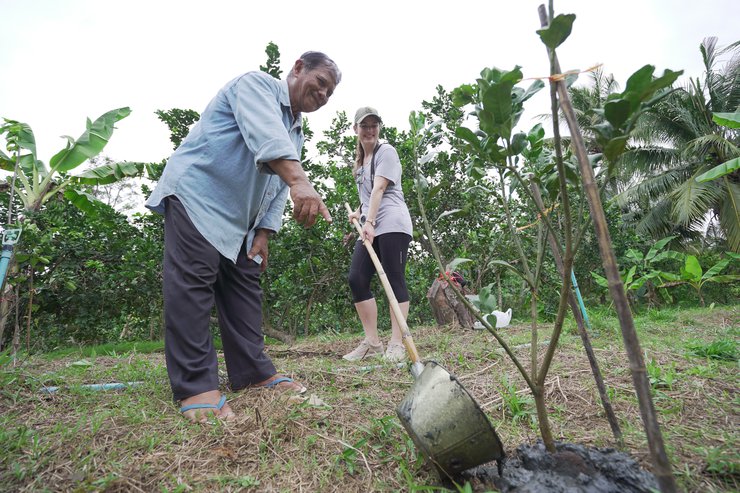
Planting a new pomelo tree
We cut a branch, we add soil to another (this is the part that tricks the plant into growing new roots), and we plant one that has been prepared earlier.
I loved getting my hands dirty and planting new pomelos. I also loved getting to taste a ripe pomelo - it's like a giant, sweet grapefruit with really defined segments that are juicy and tart and delicious. I'm a fan!
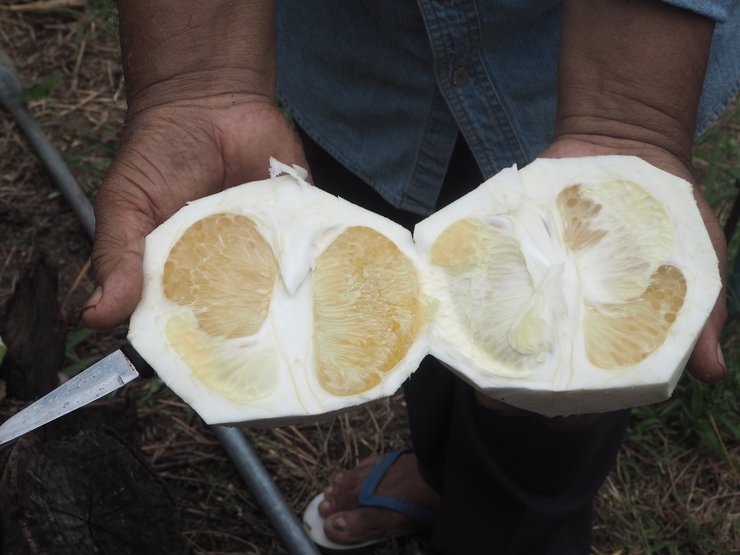
An almost-ripe pomelo, straight from the tree
We then walk a bit further into the lush orchards to find a coconut flower being harvested. The woman gathering the nectar is nothing short of a legend - she's armed with a machete and she flies up and down the ladder to detach the full container, slice off a sliver of the flower to encourage more nectar to flow, and reattaching the new container to collect again later.

A coconut flower being trimmed to encourage more nectar production
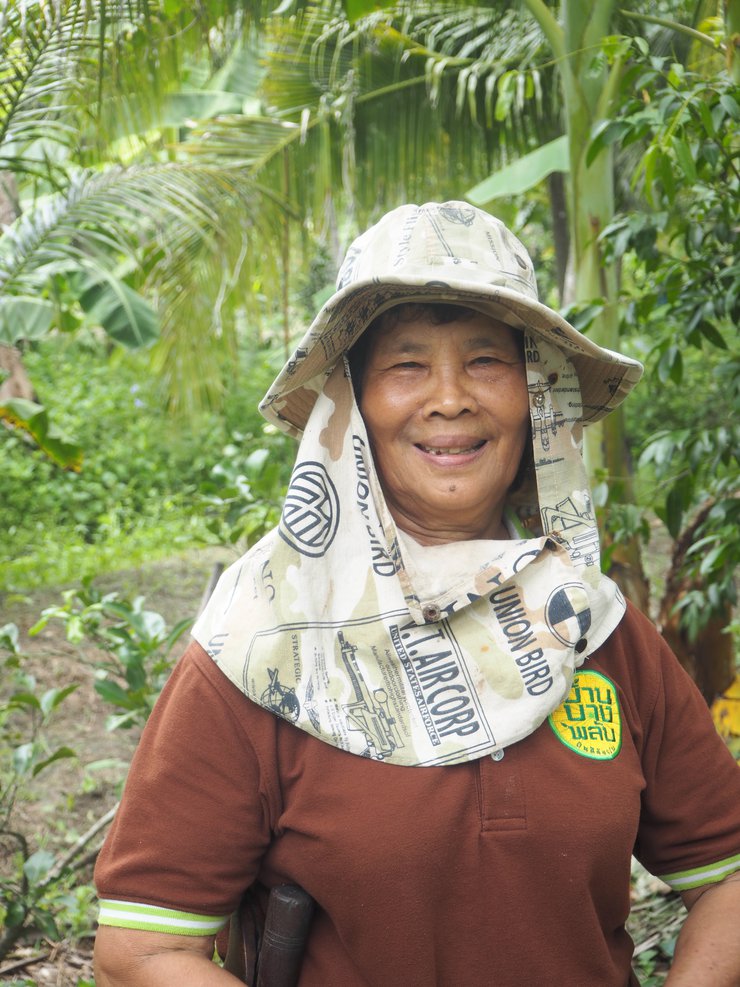
The wonderful woman who collects coconut nectar
She then knocks a few green coconuts off another tree, deftly hacks at them with her blade, and within seconds we have bowls of fresh, cool, coconut water to sip. She even fashions a spoon from the coconut shell so we can scoop out the slippery flesh to eat.
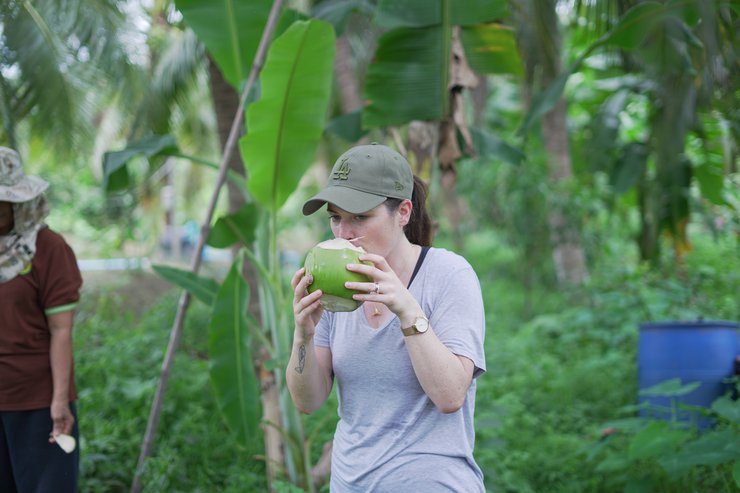
Coconut water doesn't get any fresher than this!!
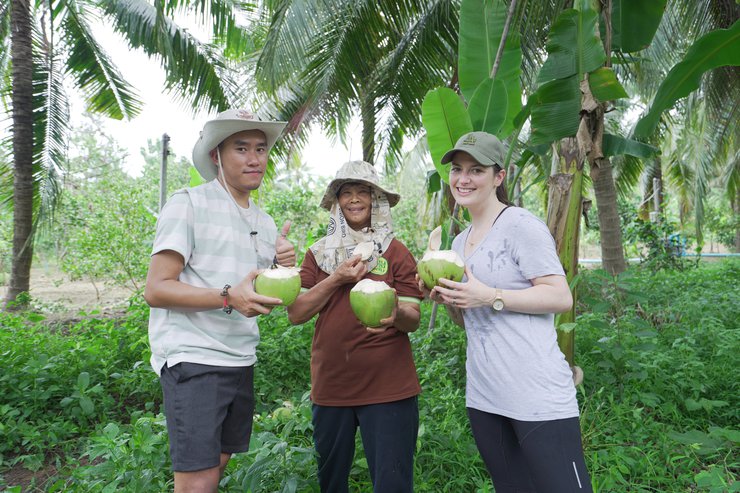
We love coconut water!
After lunch back at the community centre, we head back out on our bikes to a nearby fruit preservation centre, where we learn to make an amazingly intricate Thai sweet treat that's named after a bird's nest because, well, just look at the pictures!
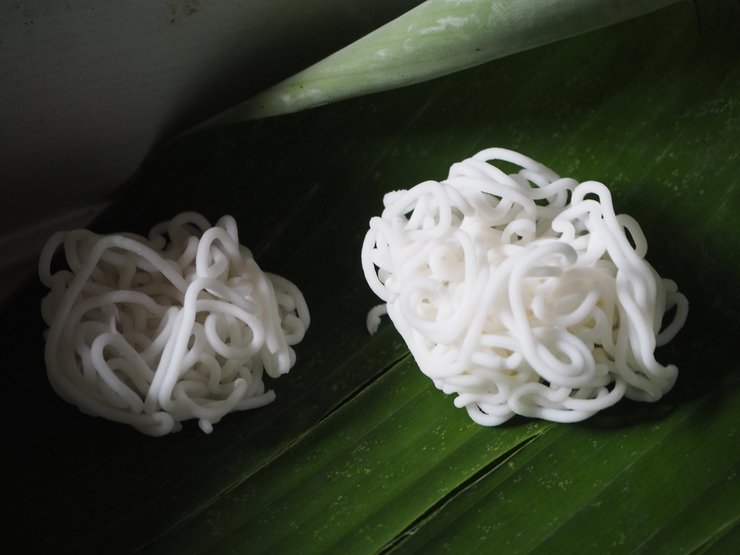
Thai sweet snacks
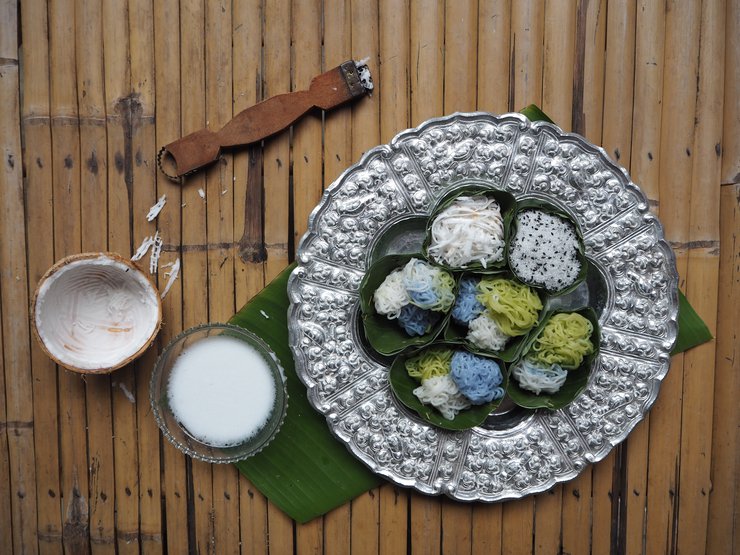
Multi-coloured rice and tapioca dough served in banana leaves
It's made by creating a dough with a mixture of rice flour and tapioca starch, as well as water and some coconut milk. This is mixed over a low heat (with food colouring if you want to get fancy) until it's doughy in consistency.
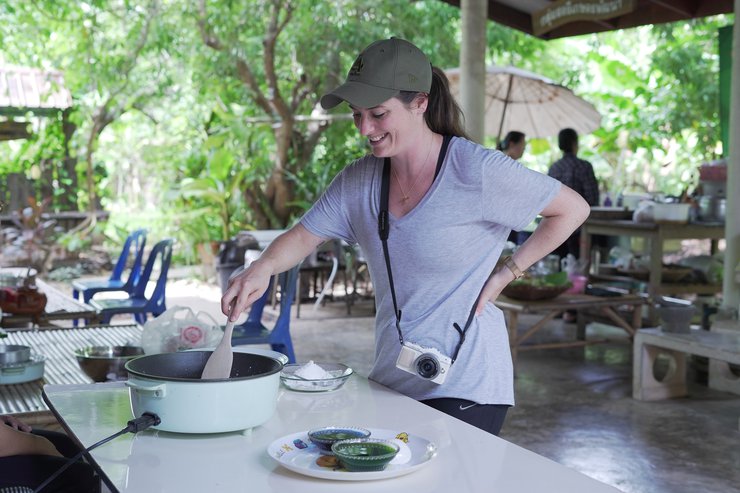
Stirring the dough
When cooled, add a bit more tapioca and knead until smooth. Then it's time to pass it through a handy contraption that's a little bit like a giant garlic press.

The finished product: sweet, with a tiny bit of salt and crunch!
The colourful little nests are then steamed, and topped with more coconut milk, sugar, sesame seeds and fresh coconut shavings. It's every bit as fun to eat as it is to make!
And finally, we're shown how to create a Thai prawn red curry, using local prawns caught this morning. The ingredients are all familiar: chilli, ginger, galangal, lime, lemongrass, red curry paste, and basil (although the basil here looks and smells very different to what I use back home), but somehow, as it all comes together, it smells like nothing I've ever made at home!
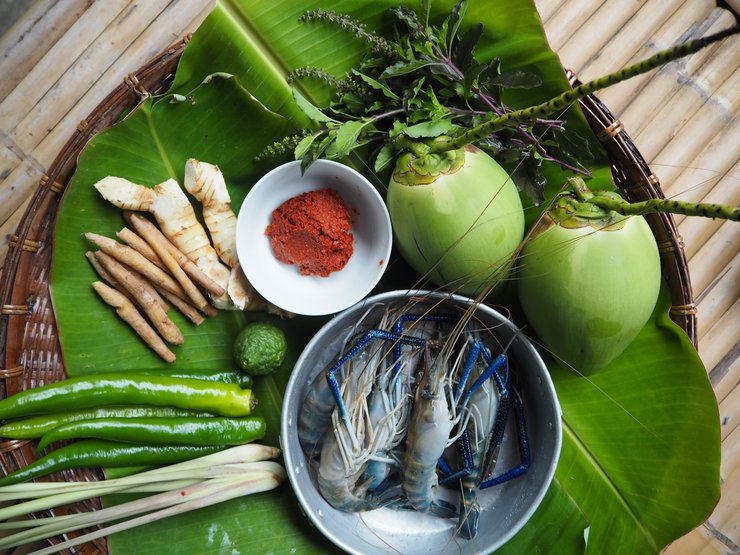
Ingredients for our curry

I wish I could capture the smell for you...divine!
The curry is carried back to the homestay, where we eat it accompanied by the music of an instrument made from a coconut, and played by Somsong Saengtawan and his three-year-old granddaughter, Alice.

Somsong and Alice performing for us
It's magical. It's heartwarming. It's the perfect end to an incredible day.
DAY THREE
We drive outside of Ban Bang Phlap, stopping at 7-Eleven, which my guide is strangely excited about. It's her favourite shop, because it "sells everything." And it truly does. I leave empty handed anyway, and we get back on the road, driving a short distance to the Khlong Khon Community. We park at Baan Mai Chai Lane Resort, which features beautiful cottages on stilts and which is, just like everywhere else, exploding with green foliage of every shade.We're led along a path and across a road to a dock, where we board a tiny little boat that chugs along the waterways, with stilted houses half hidden by mangroves on either side of us. 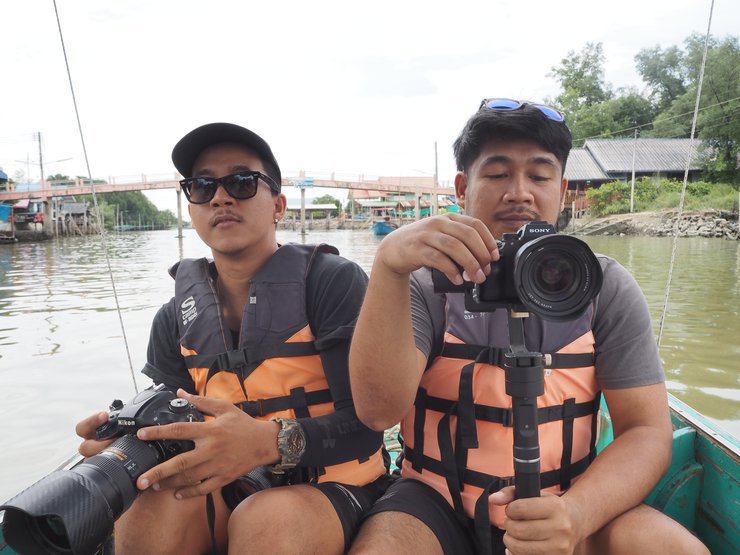
Our camera crew - with us wherever we go!
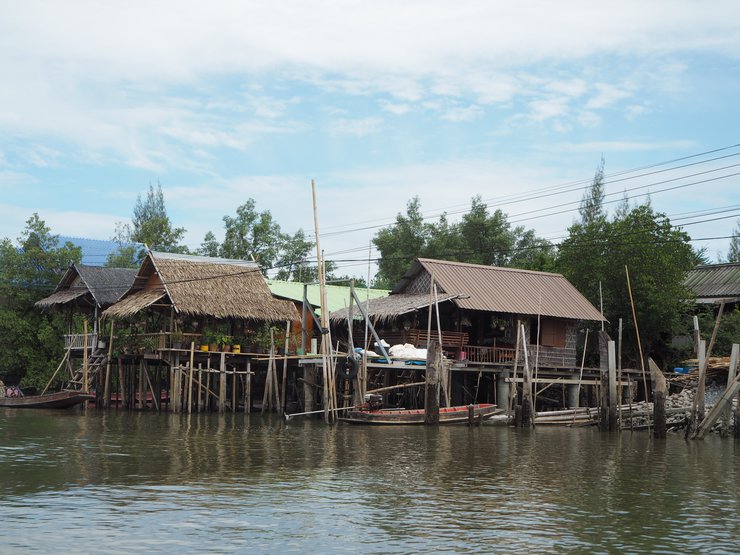
Stunning houses on stilts
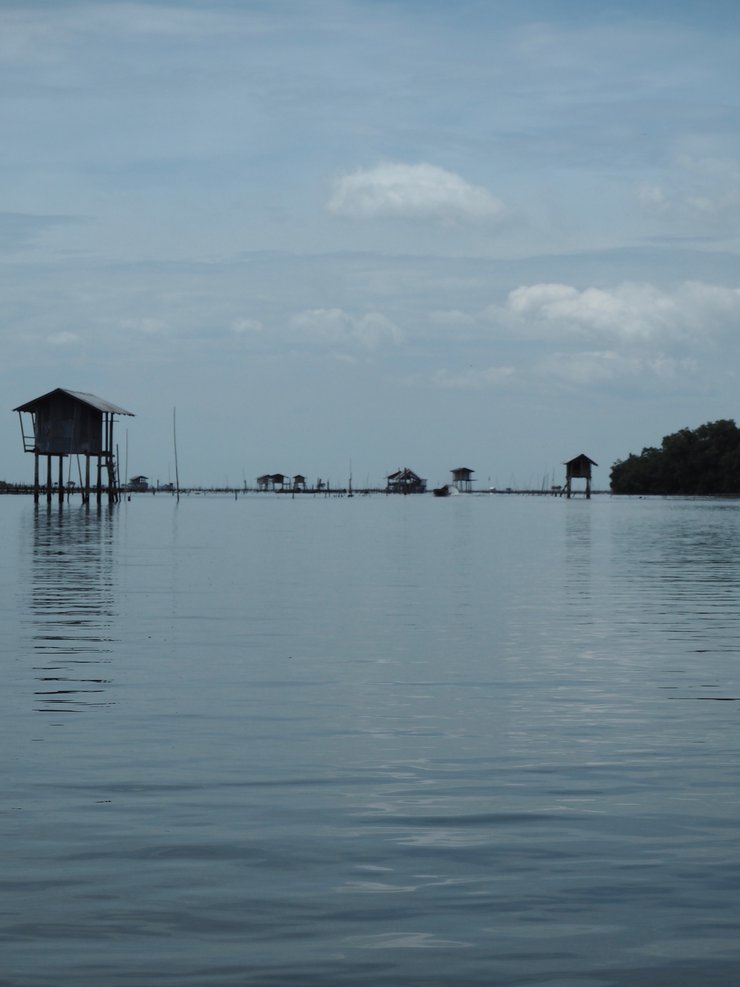
Fishermen's huts along the water
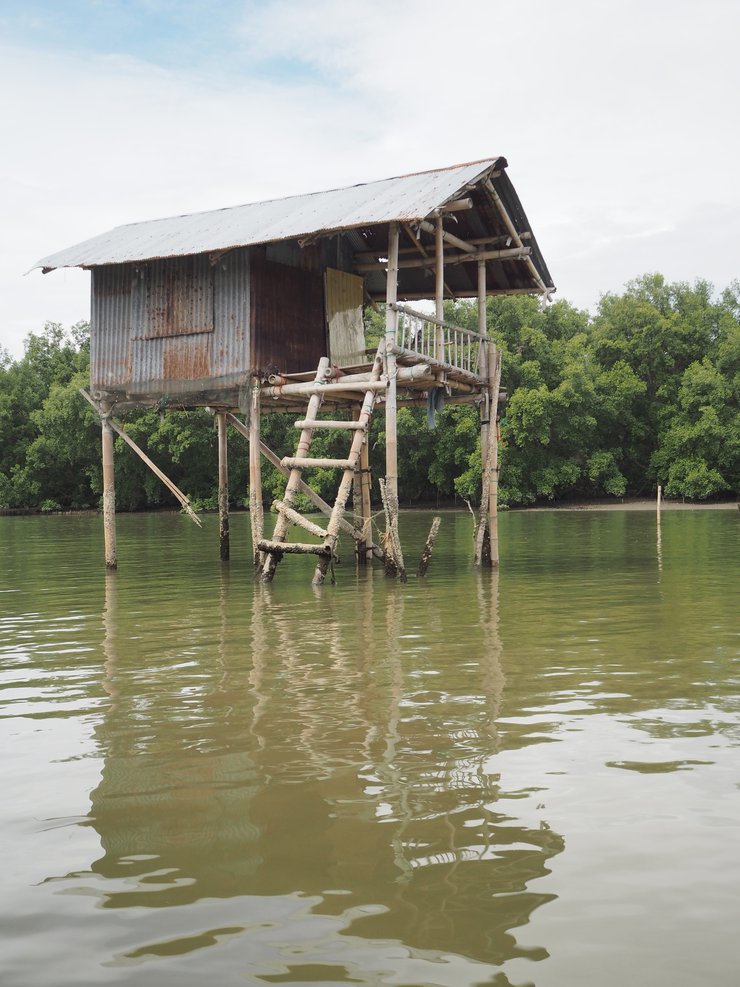
A traditional clam fisherman's hut
After a while we turn down a smaller channel, even more lush and green than before.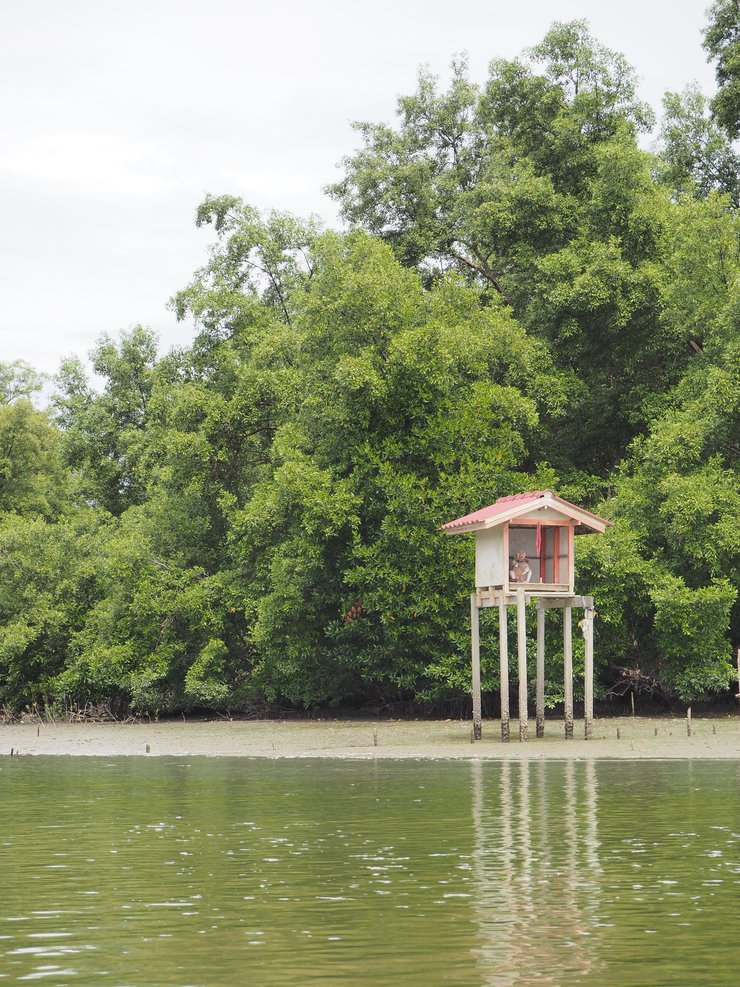
A shrine with a monkey statue guards the entrance to the waterway
Something skips across the water ahead of us. I tell myself I'm imagining things. A few seconds later, I see it again. It looks like a fish, or a frog, but instead of swimming, it seems to be running across the surface, half-submerged. "What was that?" I cry out. A walking fish, I'm told. I ask again, assuming that something has been lost in translation, but also questioning everything I thought I knew about marine life. Turns out, it is a walking fish. Sort of.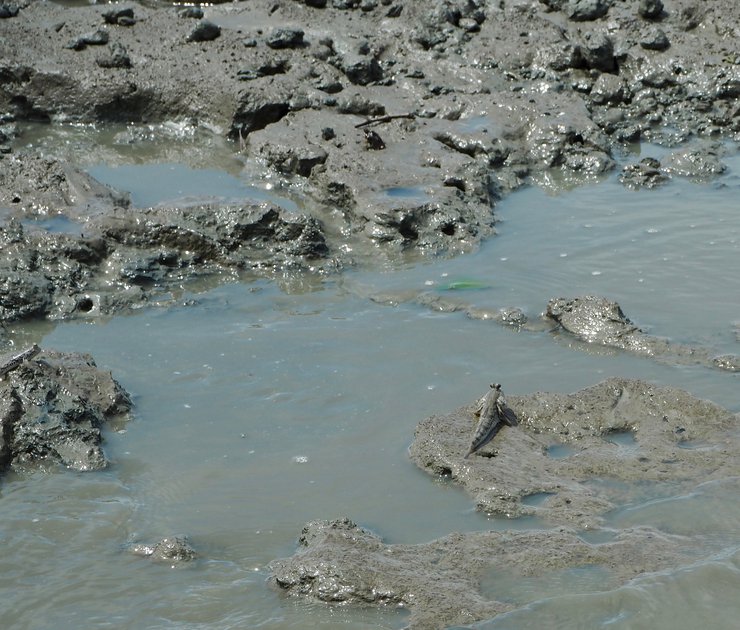
A mudskipper walking across the mud
It's called a mudskipper, and it's an amphibious fish with such powerful pectoral fins that they can jump distances of up to two feet, and they've even been known to climb trees. WILD. I see plenty more over the course of the day, and I grin from ear to ear every single time. Walking fish! Who knew?!Soon the boat slows almost to a halt, and as we drift past leafy mangroves, I see movement among the branches. Monkeys.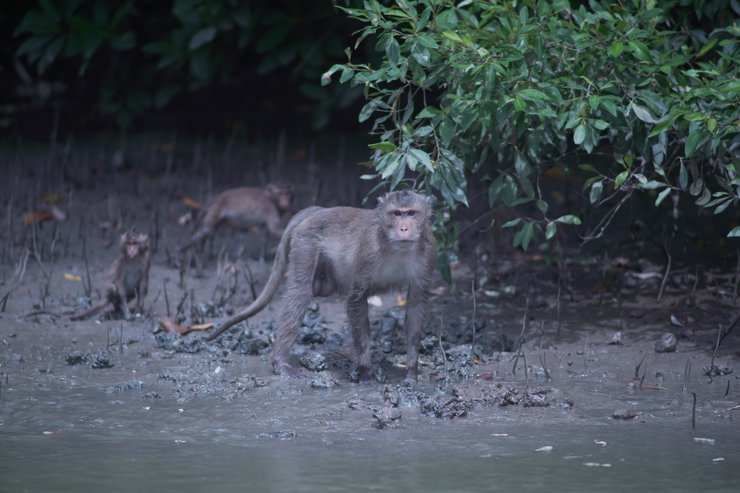
The monkeys of Samut Songkhram
A baby clinging to its mother, a huge male watching us suspiciously as we float past, and plenty of others of all sizes digging in the mud for crabs. Apparently these monkeys swim, but we didn't see any in the water today. Perhaps it just wasn't hot enough (jokes; I'm melting)!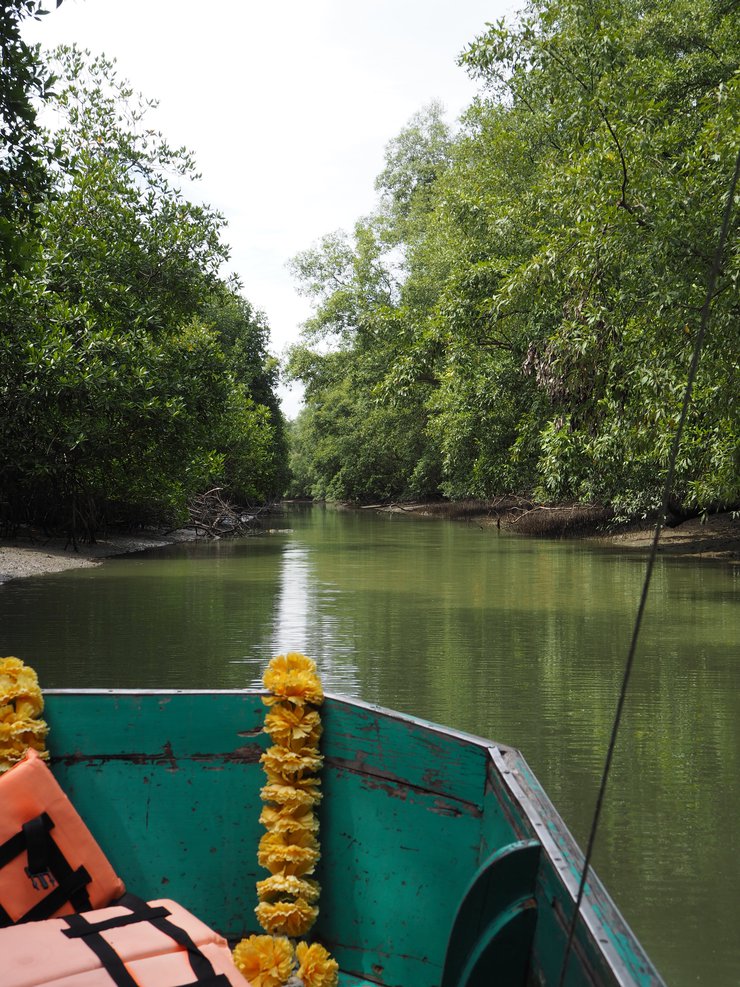
Travelling through the mangroves
We leave the monkeys behind and head further into the mangroves. The boat stops, and I'm directed to get out. Our boat driver and guide pads barefoot across the mud with ease. I step out, and immediately sink into warm, smooth mud that comes up to my knees.
Planting new mangroves and getting stuck in the mud!
I try to take a step, but it's next to impossible. With a squelch and a heave, I lift my leg and step further in, only to sink again, the mud closing around my leg, holding me firmly in place. Our guide hands me some mangrove saplings, and shows me how to plant them. I press my heel into the mud, place the mangrove roots into the hole, and use my foot to push the mud around it, holding it securely upright. In just a few months, this will be a flourishing tree, providing a habitat for local wildlife. It's difficult work, with each squishy step pulling me further into the mud. By the time I try to reach the boat, I'm thigh deep in black sludge. It's kind of awesome.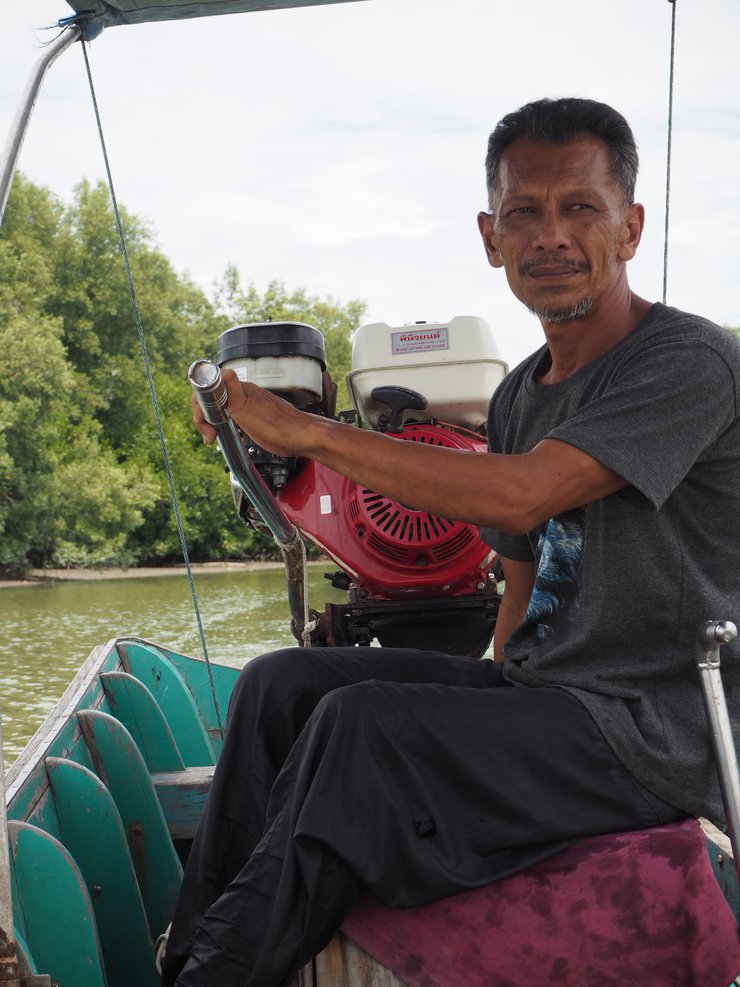
Our boat driver
It's a struggle, but I make it to the boat again and the guide helps me to clean the mud from my legs and feet using a mesh cloth. We then putter out to sea, to the fishermen's huts that are dotted across the water.
A fence along the boundary of a clam farm
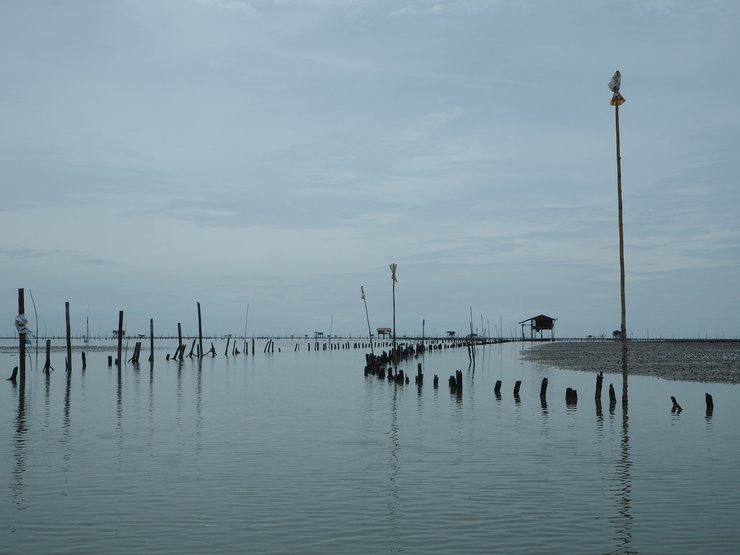
'Roads' through the farms
The fishermen live in these huts so they can check their nets or 'fields' (not actually certain what the correct term is for an area of sea water used for farming) regularly, and they stick up out of the still water of the Gulf of Thailand like rickety storks. We pull up alongside one of these huts, which is the cockle farm of Baan Mai Chai Lane Resort, and it offers its guests lunch and activities such as kayaking. When we arrive, lunch is laid out for us, the low table overlooking a panoramic vista in every direction.
Lunch in a clam farm

The freshest seafood!
We eat, the seafood fresh and delicious, and then I collapse into a deck chair and drift off to sleep...I wake, sleepy and satisfied, the sun beating down, and it's time to go again. We get back into our boat and venture further into the water, this time to an oyster farm, where strings of oysters hang like ornaments from the house above. We pull them up, the barnacle-encrusted shells, a year in the making, clinging to the ropes above, a year in the making.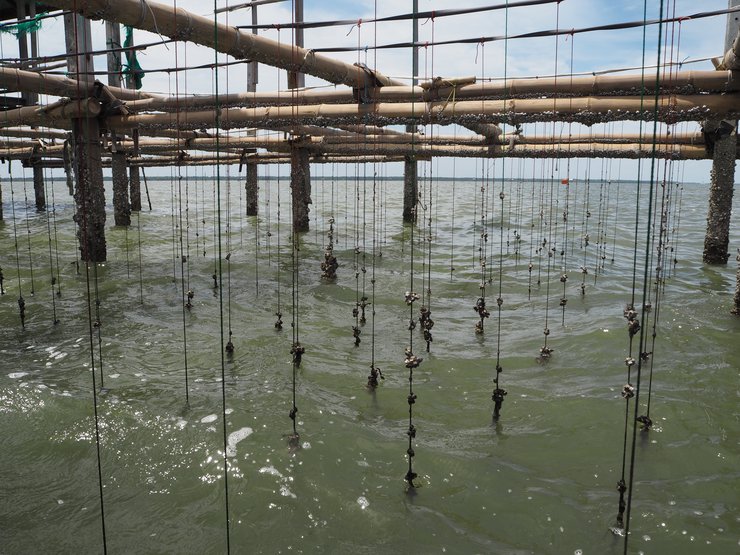
Ropes holding clusters of oysters, and hanging from a hut

Oysters!! They're heavy...
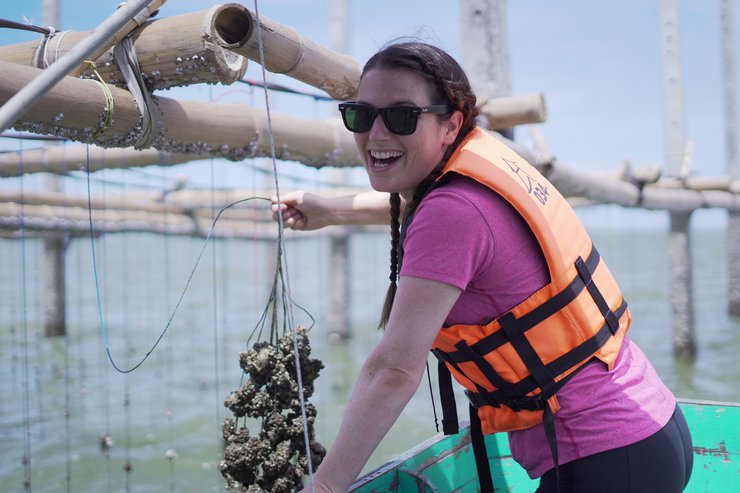
I'm thinking about how much I'd like to eat these...!
On our way back, we stop at a muddy field for some mud sports. The mud is a quite dry, so it doesn't offer its usual slippery surface, but we hop on a board - a bit like a really long skateboard without wheels - and try to propel ourselves across the surface.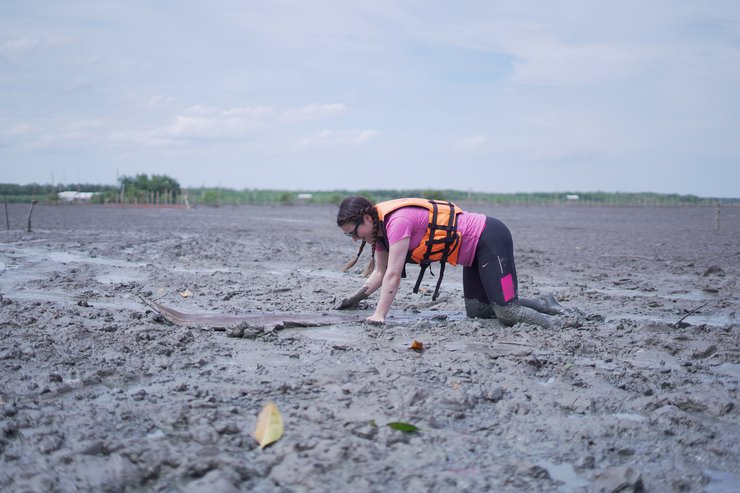
Mud boarding is harder than it looks!
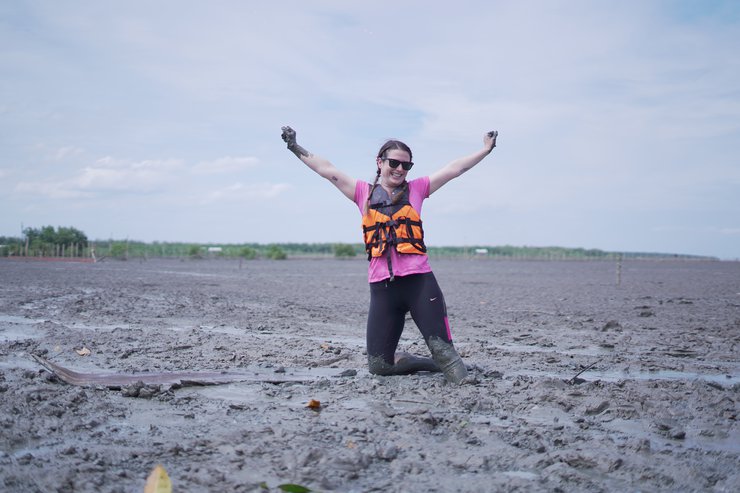
I did it! I moved like, two metres!
It's much, much harder than it sounds, and I manage to get about five metres across the mud before I give up, exhausted.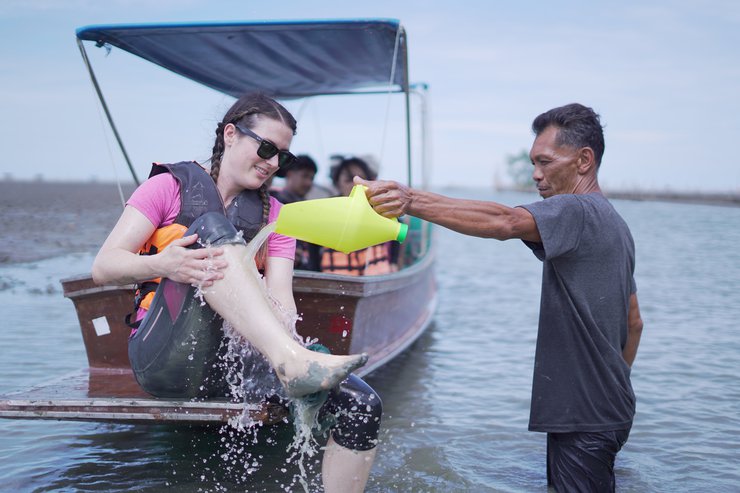
Getting cleaned up
But playing in mud is always fun, so it is worth the mess and the tiredness. We get back to the resort - after my Thai teammate Q shoots some incredible drone footage - and I shower the mud from my body, (although it's still very much on my clothes!) before returning to the Ban Bang Phlap Community Centre.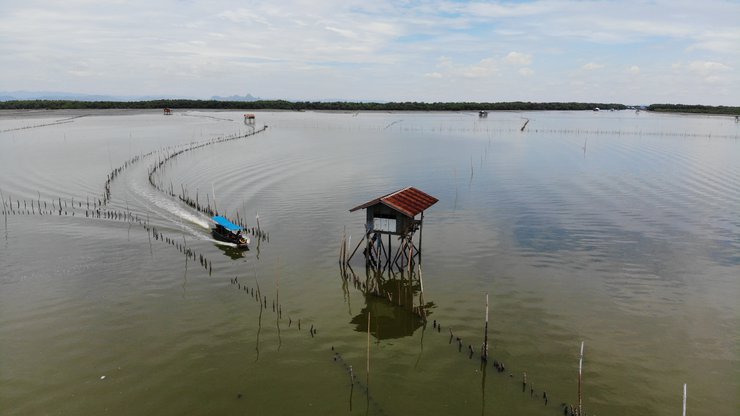
Drone footage thanks to Q
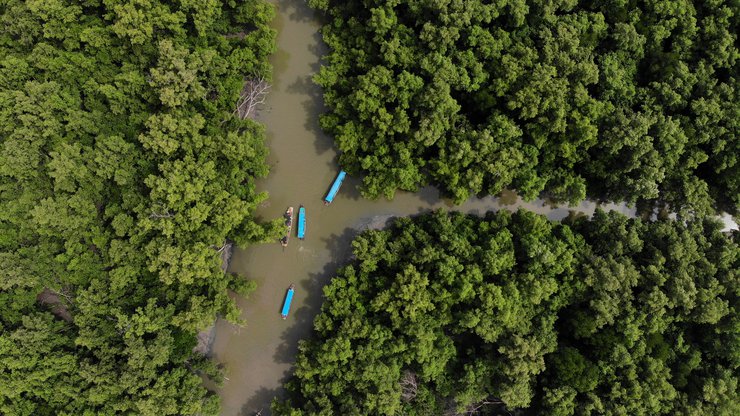
The mangroves from above
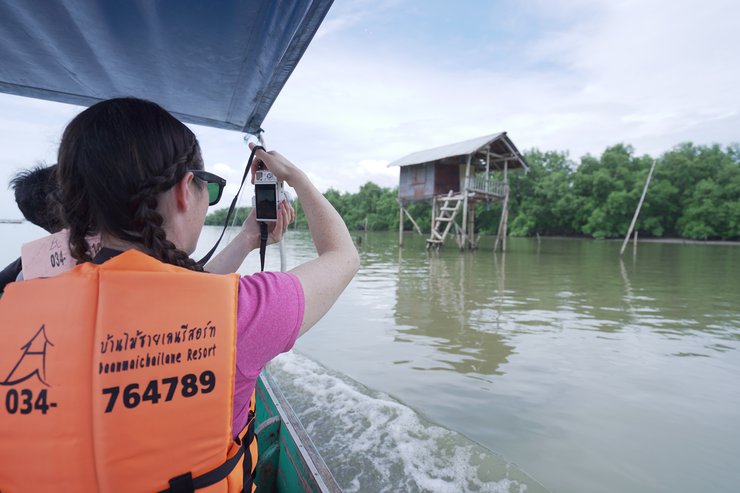
These huts are so picturesque
As I type this, I'm sitting in the open-air living area, a fan pushing cool air towards me, a cold drink made with local herbs by my side. Stray dogs wander around, motorbikes zoom past, and the call of birds from the orchards behind me is my soundtrack. Dinner has just been delivered nearby, cooked by the local woman who taught us to make the curry yesterday. I can't wait for another feast of flavours. I can barely believe another day is almost done, but I'm already excited for what tomorrow has in store for me. I'm certain that whatever it is, it's going to be unforgettable.DAY FOUR
I arrived in Thailand knowing exactly nothing of the Thai language. Now that I've been here for four days, I know three phrases: thank you (kop khun ka), hello (sawadee ka), and how much? (tao rai ka). Please excuse me if I've butchered the spelling there. It's not exactly a recipe for smooth communication. My guide, Lucky, speaks fantastic English, but there's always a sense that the connection between me and whoever I'm speaking to is lost in translation.
And yet, this morning, I am to experience the type of connection that doesn't need any translator: human to human, with a smile, a mutual understanding. It is a humbling moment. A reminder that there's more that connects us than what separates us. That there's always common ground, even if it's just a shared appreciation for something beautiful, like a jewel-toned lotus flower.

The vendor selling lotus flowers at Tha Kha Floating Market
When we arrive at Tha Kha Floating Market, I'm instantly mesmerised by the colours, the smells, the fruits I've never seen before, the smoke rising from the long, narrow boats that cling to the riverbanks or float lazily, the tide taking them past me.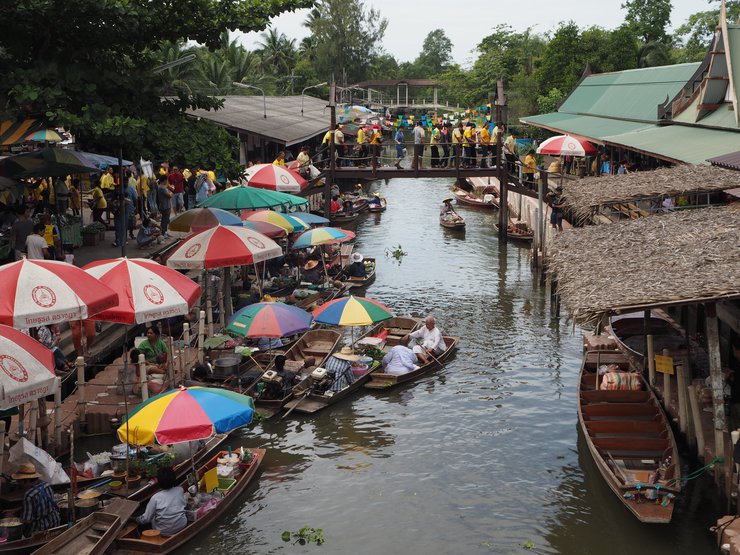
The bustling Tha Kha Floating Market on Saturday morning
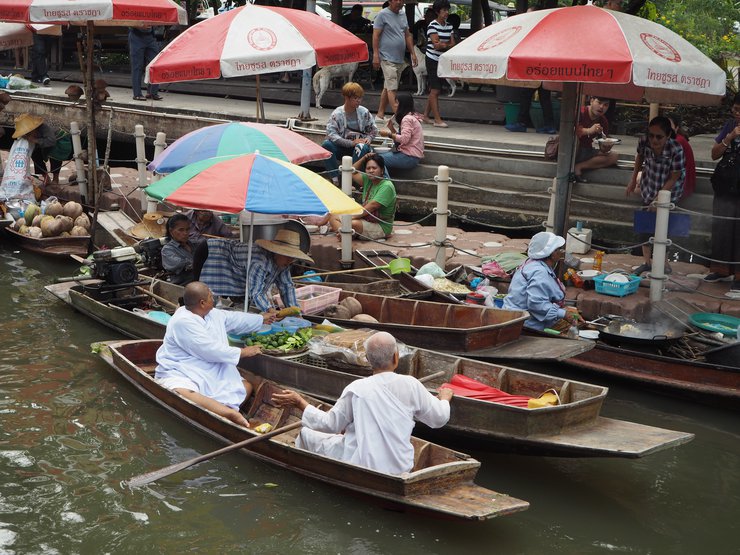
Monks at the market (apparently white robes mean they're female)
I wander around, unsure where to start, what to eat. We haven't had breakfast yet, and my stomach is rumbling. I'm overwhelmed by the options; here, sweet, there, savoury, over there something which I just can't categorise. Lucky buys some snacks from an 80-year-old woman who tells us about the history of the market.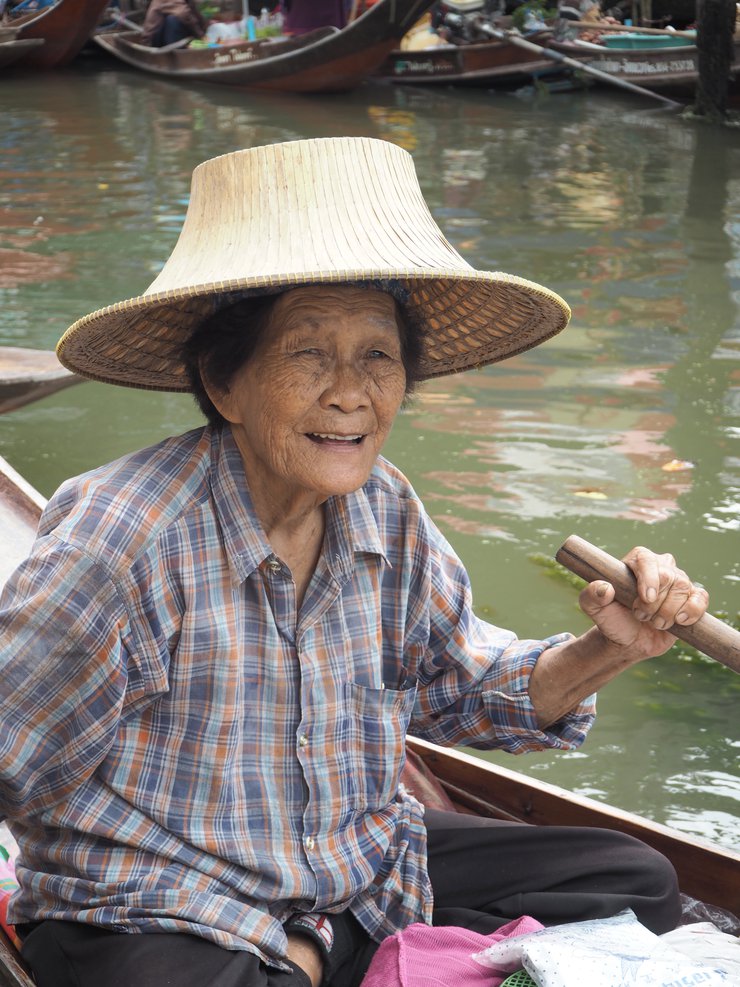
This woman has been selling at this market since she was very young
It used to be the place where fish farmers from the sea and vegetable farmers from the river would meet to trade their wares. Because of the tides, they could only meet on certain dates: two, seven, and twelve days after a full moon, and the same again after a new moon. Modern technology has made transport much easier, so now the market takes place on weekends, too. Lucky tells me that the woman has been trading here since she was a young woman. Her boat is laden with garlic cloves, small onions, chillies, coconuts and cabbages. I gesture with my camera, and she nods, quick to smile brightly. "Kop khun ka," I say. We smile, move along to another vendor, this one selling noodles in fragrant broth.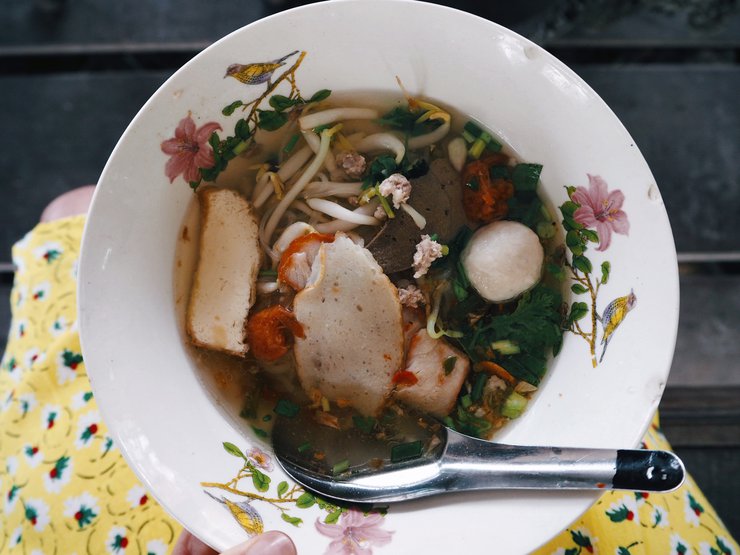
Delicious breakfast!
I sit to eat my meal, which is incredibly tasty. I'm getting used to these deeply savoury breakfasts, things I usually wouldn't eat before noon.Soon I'm wandering again, followed by Aum and Nat, our team's camera and video guys. At first their presence was unsettling, with constant retakes and poses. But we're starting to get to know one another - shyly, with almost no words in common - and now we find ourselves laughing together at jokes we can't explain, and don't need to. I marvel at fruits and vegetables I've never seen before. I try Thai mulberries (tart, like a small blackberry). I see fresh tamarind (I've only ever seen the paste), and bitter gourds. A young girl demonstrates how to use a pair of coconut halves joined by string as a toy. And then I spot the lotus flowers. They're impossible to miss, really. They're right at the front of the boat, the rest of the wares fresh and green and neatly laid out. I comment to Lucky that they're beautiful. She tells me to buy them.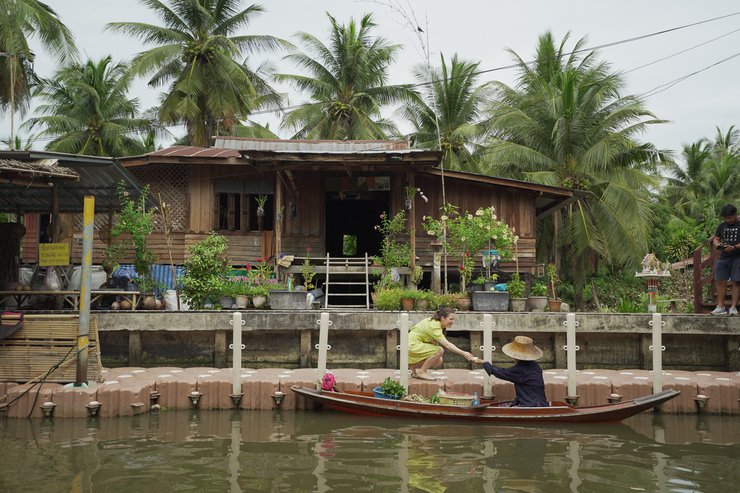
Buying lotus flowers from the vendor
I shyly walk over, and ask the woman, "Tao Rai Ka?"I hear "Baht", but have no idea what number she said. I hand over a 20 Baht note. She gestures the number two. I gently lift a bunch of the lotus flowers, and she gestures again. "I can take two?" I ask, unsure, not wanting to offend (or, you know, steal). We look at one another uncertainly, and then slowly, I take another bunch. She nods. She gestures for me to smell them. I inhale the sweet perfume, indicating that it's lovely. She then makes an eating motion. I don't understand. She reaches up and snaps off a piece of the stem, deftly peeling it and popping it in her mouth. She gestures to me. I nod, and she peels a piece for me. I sample the stem. It's mild, but refreshing.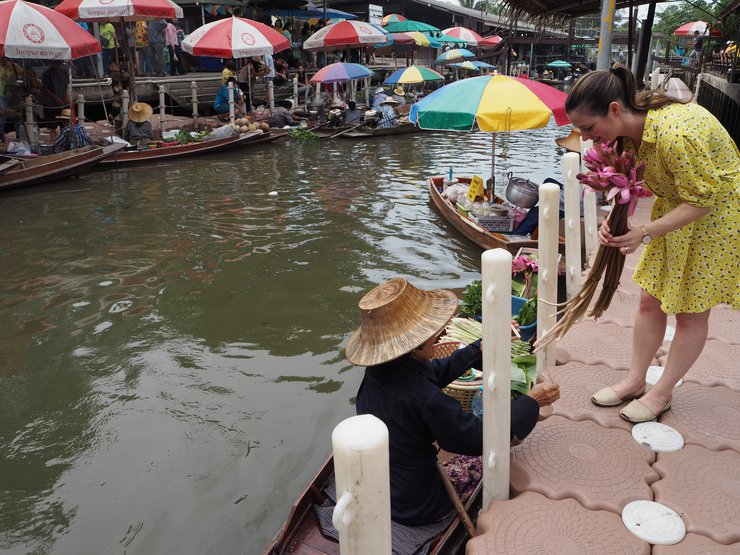
Watching as the stem is peeled for me to eat
We smile. "Kop khun ka," I say. She smiles again, and then I step away, back towards Lucky and the rest of the market. It's only a tiny moment; insignificant by all accounts. And yet it affects me in a way I find difficult to articulate. Maybe it's because, having lost control of easy verbal communication since being on this trip, being able to connect in the smallest way feels like an incredible feat. Or perhaps it's because I overthink what connection means. I intellectualise it, when actually finding common ground with another human is nothing more complex than a smile, and a willingness to learn. I don't know. Whatever the reason, it was a surprisingly profound moment for me, and one I won't quickly forget.Before heading back to the community centre, we sit in a lush little coffee shop on the river's edge, sipping iced coffees and talking and laughing together, more connections being made constantly. I'm overwhelmed by the warmth of Tong and his family, who are hosting us at Ban Bang Phlap. His wife, Nong, and daughter Alice, are generous with smiles and laughs, and although I know almost nothing about them, really, I feel like we're all somehow getting to know one another.

Delicious coffee at Tha Kha Floating Market
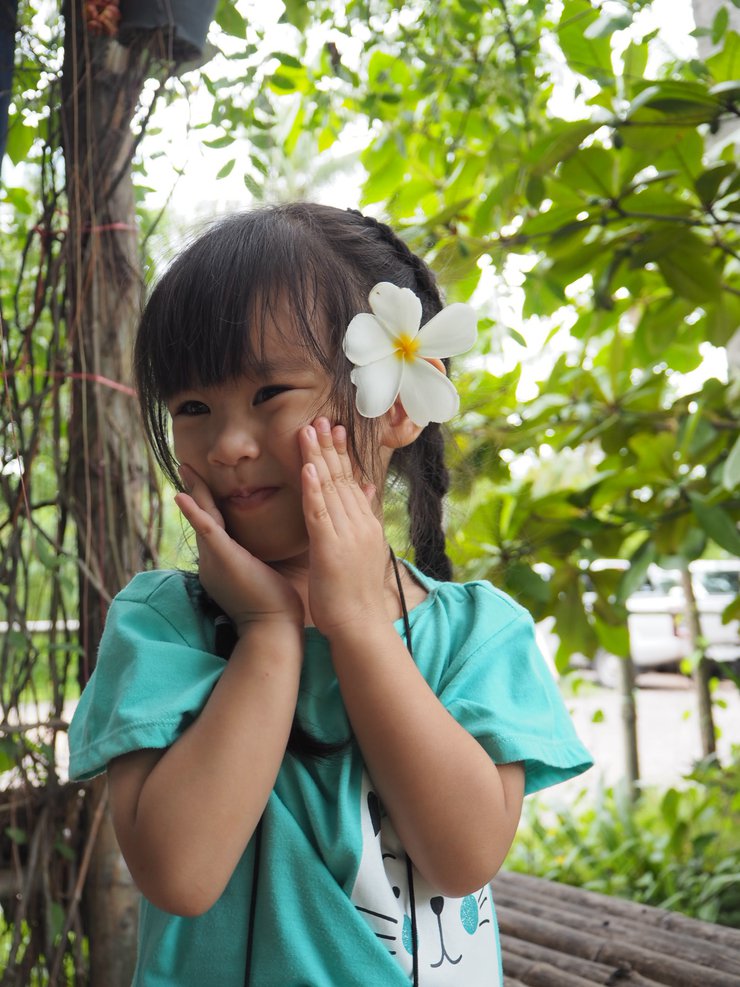
Alice being adorable
We eat lunch, and although I'm still full from breakfast, I can't resist trying a real Pad Thai, which is my all-time favourite dish. It doesn't disappoint!
REAL Pad Thai - it's every bit as good as I hoped it would be
After lunch we cycle to the same house where we learned to make the Thai sweets are red curry, this time for a lesson in preserving fruits. First, we cut papaya chunks into pretty little flower shapes. It's harder than it appears, and mine resembles a misshapen spider, but the woman who's teaching us expertly slices her papaya into a butterfly resting on a delicate flower. Incredible.
The house where fruit is preserved
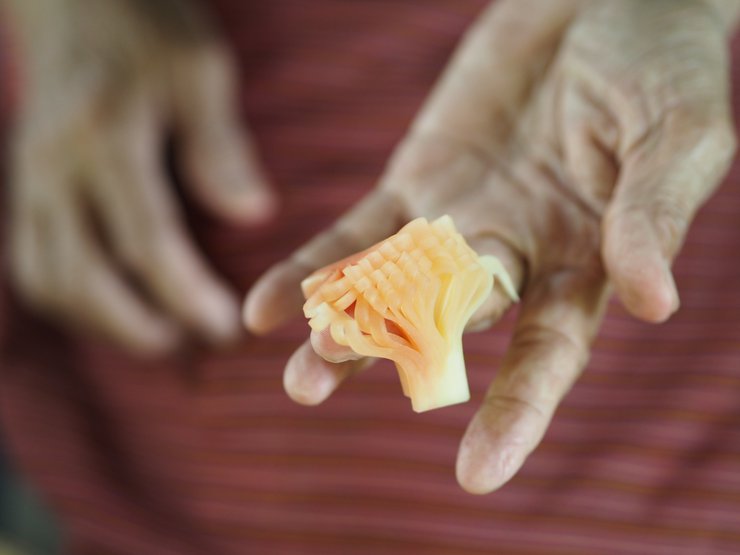
A papaya carving
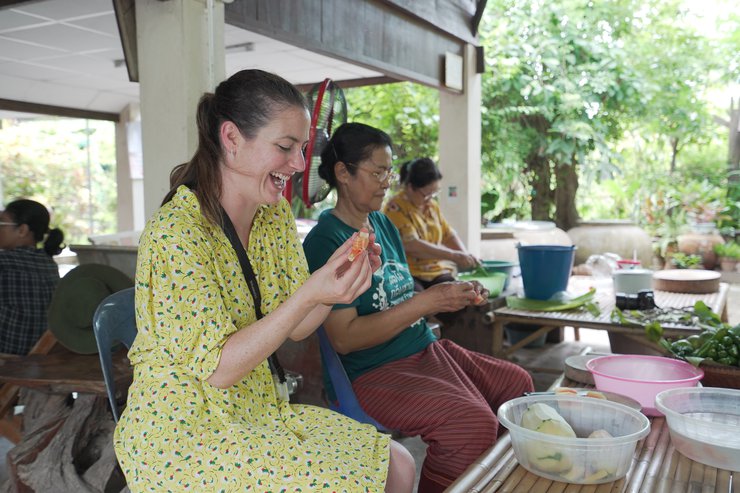
Laughing at how bad I am at carving fruit!
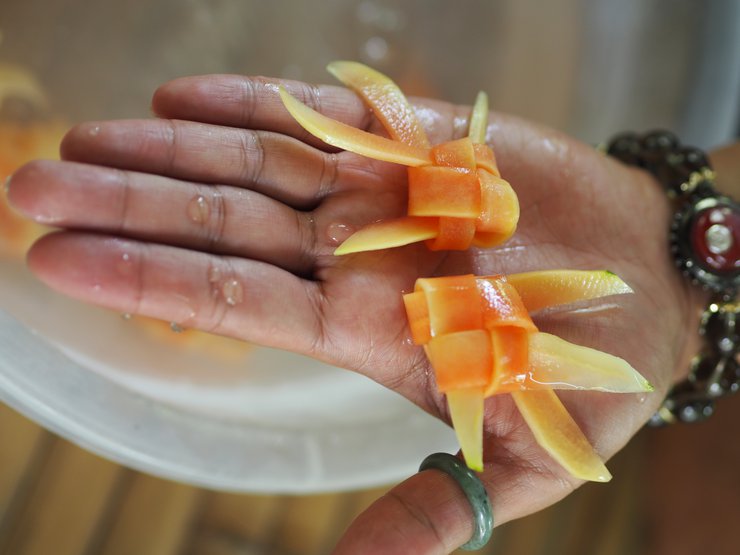
Papaya goldfish!!
We then take a bitter root plant, and peel the roots, saving the outer layer to be candied in future.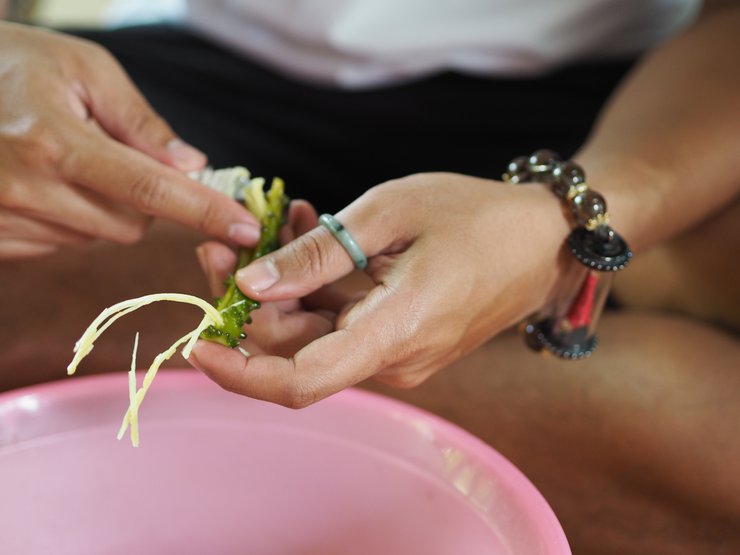
Bitter roots being prepared for transformation - only the outer part is used
The process of transforming fruits, roots and herbs from inedibly bitter (truly - Lucky made me taste a bit) to candy-sweet takes about a month, with various instances of soaking in water or salt or soda or syrup. The end result is delicious, and we're offered a platter of different candied plants to try. My favourite is the lime, which has still retained a bit of its sourness, to balance out the sugar.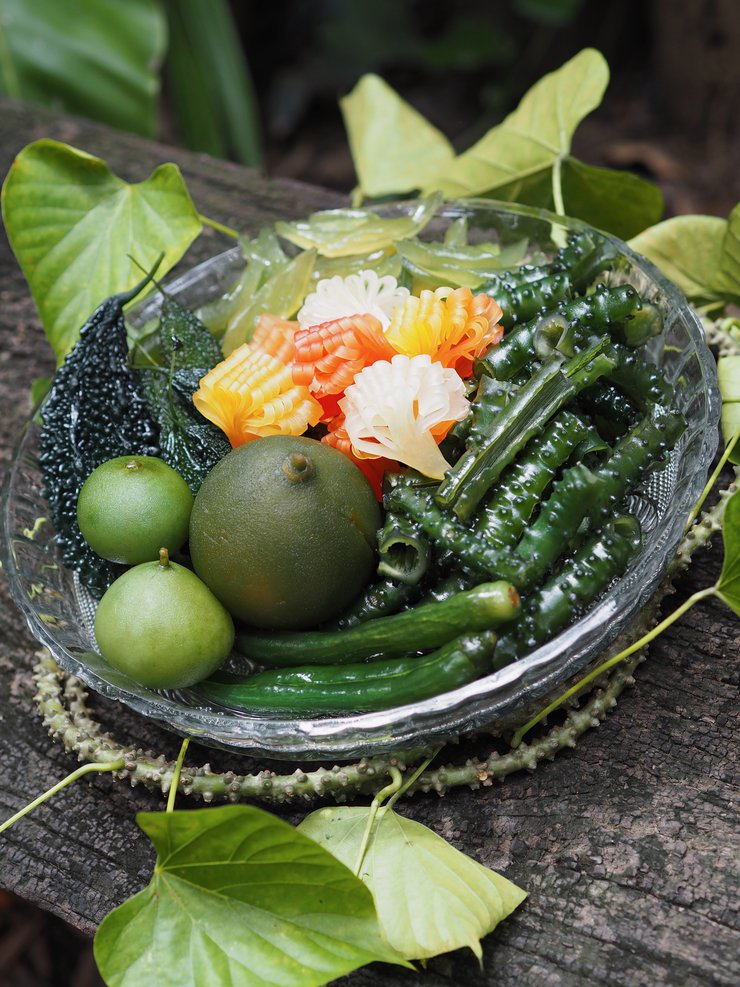
The finished product, which takes weeks to create
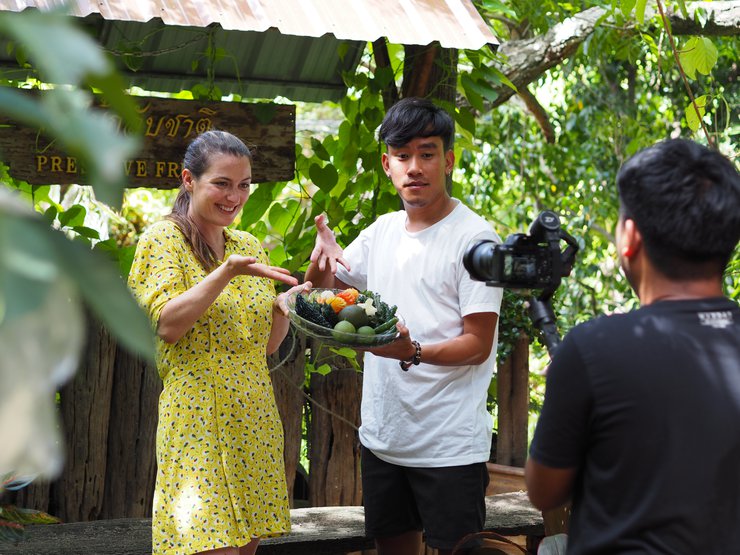
Smiling for the camera!
It's back on the bikes for us, over to another house where coconut palm leaves are used to weave baskets, hats and toys. I'm taught to make both a hat and a basket, and although I needed constant instruction, I think I managed to pull it off!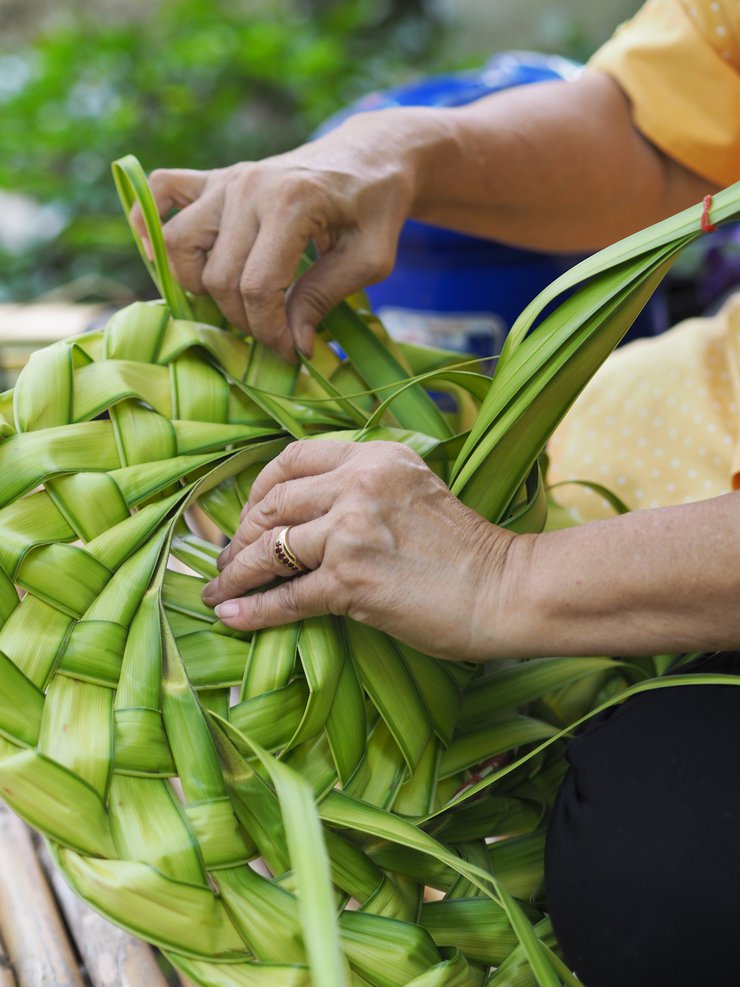
The expert weaving a hat from coconut palm leaves
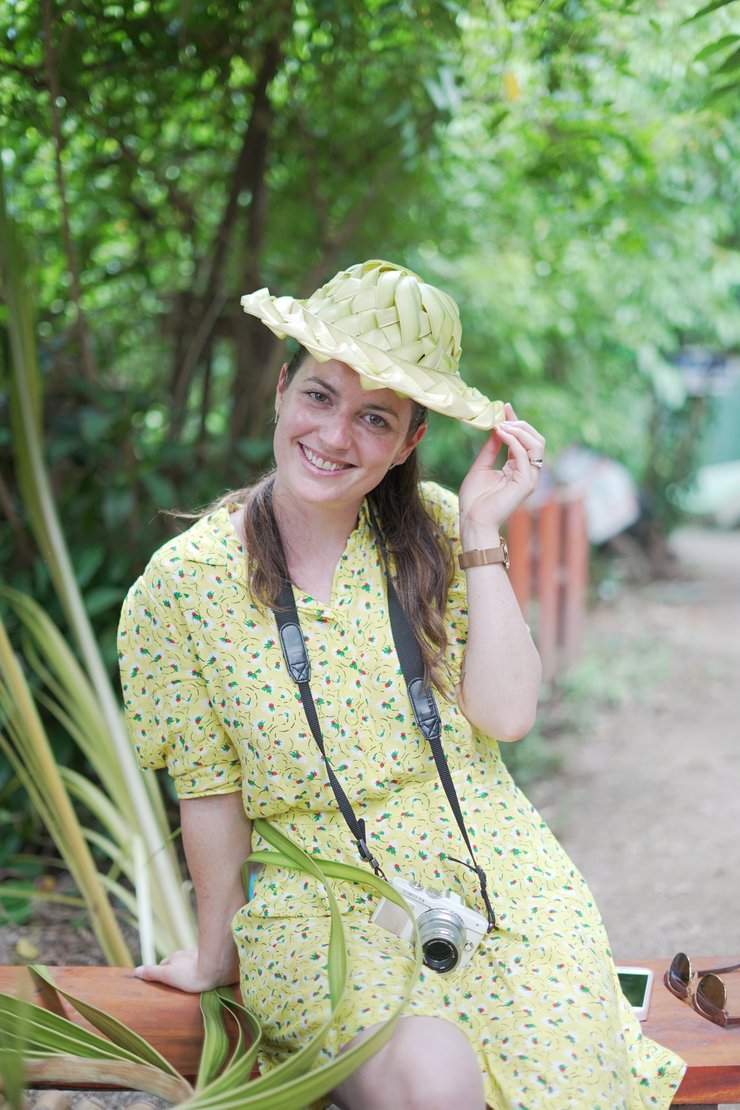
The hat I made!
Finally, it was time to head to a small, local market for a pre-dinner river cruise. The market, called the market of three cities, borders a neighbouring district, as well as another city, meaning three cities are clustered together on the water. We feed the giant fish while we wait for our boat, and then we step aboard and skim across the glassy water, watching as locals go about their day-to-day business: hanging washing, bathing, swimming, cementing their stairs, sitting and watching the world go by...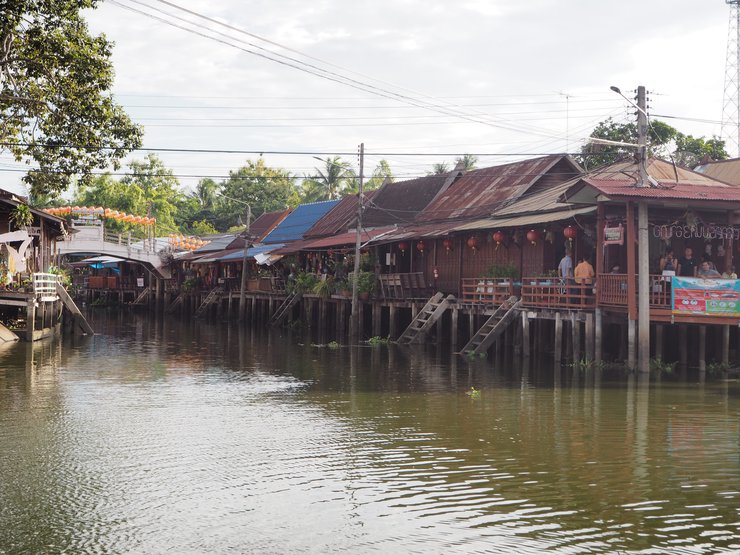
The market of three cities - both sides of this water are different districts

On our boat cruise
We get back just in time for sunset, the descending sun casting a golden glow across the water. Strangely, back at the market, there's a live open-air karaoke situation happening, as well as a group aerobics class that seems to be pretty popular.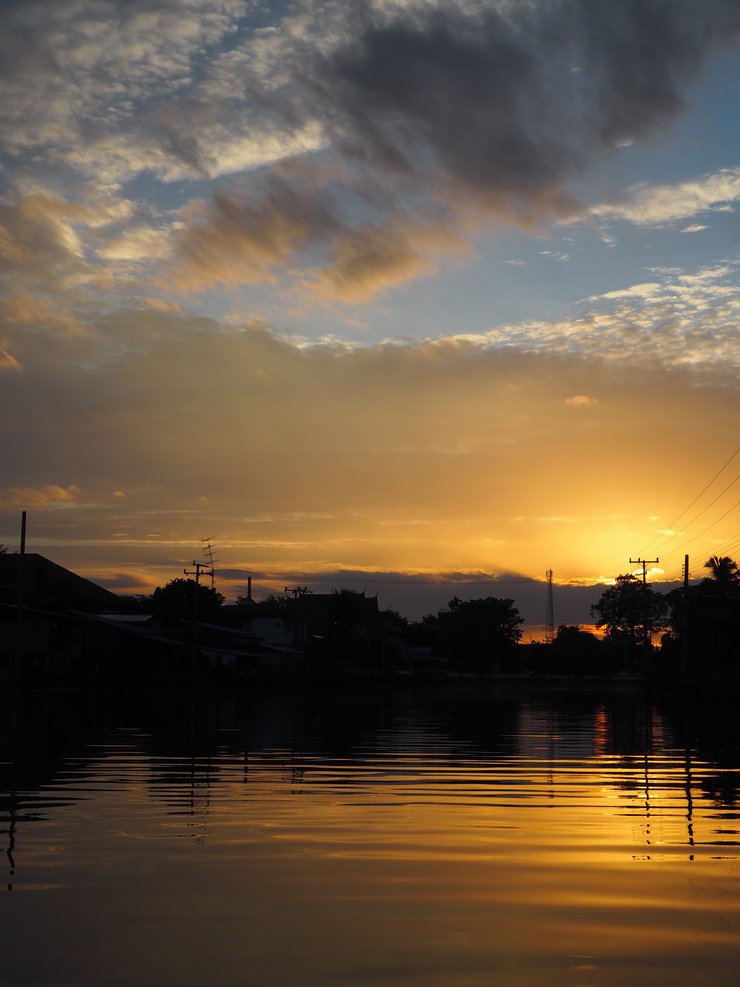
Sunset on the water
It's early still, and I'm in my lovely air-conditioned room, listening to dogs barking and crickets chirping and toads croaking. It's been an incredible day. I can only imagine what tomorrow will bring...!DAY FIVE
Today is, in a nutshell, hot.
I don't know why it's affected me so much today, especially after I've spent most of my life enduring Aussie summers. There's air conditioning everywhere here, so it's not like there's no escape...I guess I'm just more acclimatised to British weather than I care to admit!
We start our morning by - you guessed it - cycling, this time back to the same location where we learned basket weaving. Today, though, we're led further back to a large covered area complete with three fire barrels, one of which is gently smoking.
We're at the fruit charcoal centre, where fruit is baked into a type of charcoal that eliminates odours in the air, and which helps reduce waste in farming.
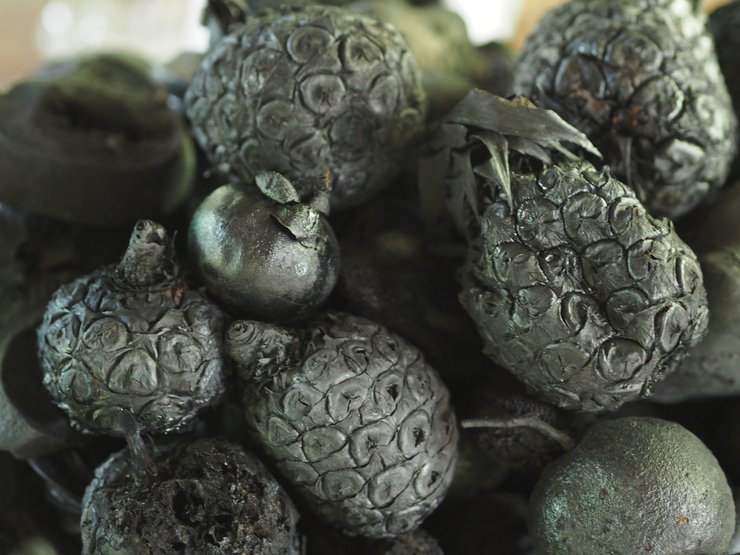
Fruit charcoal!
Rather than throwing away fruit that's too small, or misshapen, or not quite ripe enough, it's placed into metal boxes, covered in banana leaves, and left in a fire for eight hours. While that's happening, the evaporated moisture from the fruits is collected and then used as an organic pesticide. We're invited to fill one of the metal boxes with tiny pineapples, jackfruit and a handful of limes. Then we stuff banana leaves on top, start a fire in one of the barrels (well, Q does that bit!), put the tin inside and seal it up.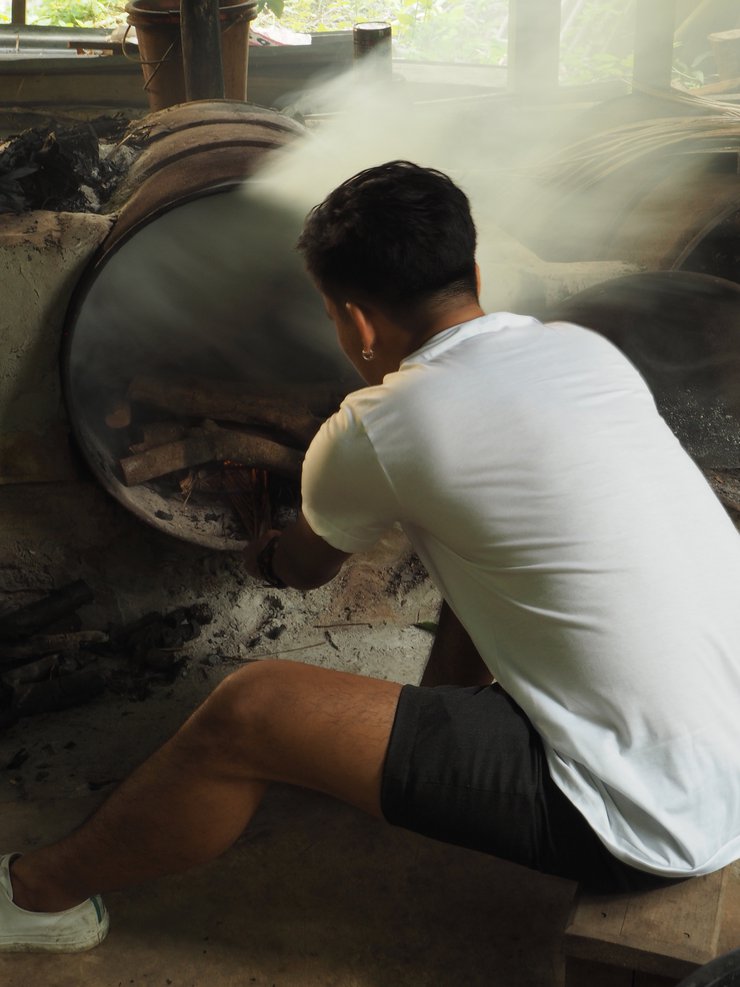
Q lighting the fire for a new batch of fruit charcoal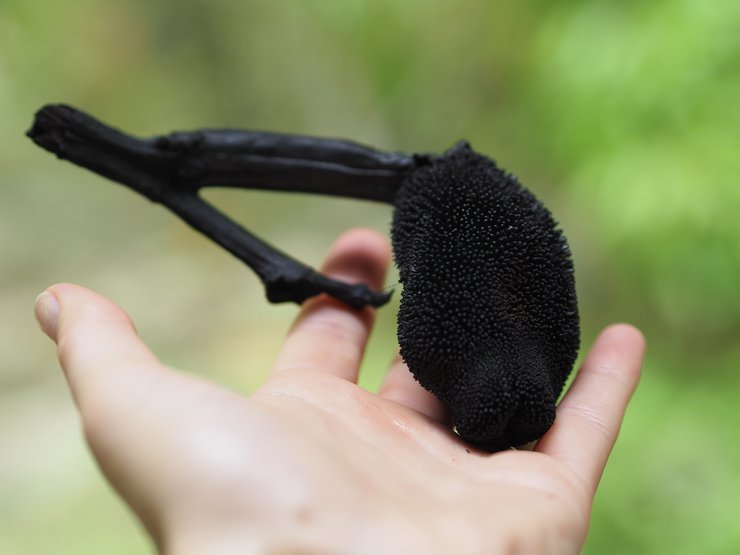
A baby jackfruit charcoal
Meanwhile, we're shown the finished product - perfectly shaped black fruit, which doesn't stain my skin when it's rubbed across it - that's thanks to them being sealed nicely while they're inside.
Next stop, just down the road, is a 64-year-old kite maker, who's been at his craft for 50 years. He's already got some frames made for us, using dried bamboo and twine, so all we need to do is glue on the paper and decorations. Still, it takes forever - well over an hour - and in the small, un-air-conditioned room, I'm sweltering!
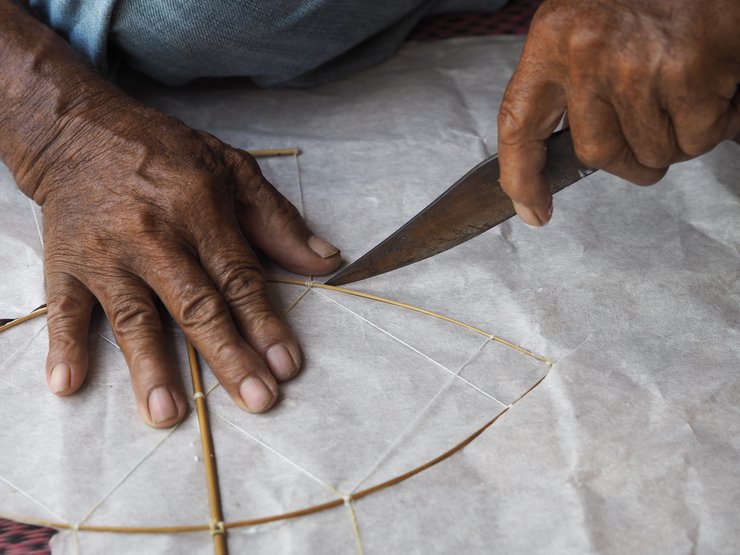
Cutting the special paper for my kite

Q glueing his kite together
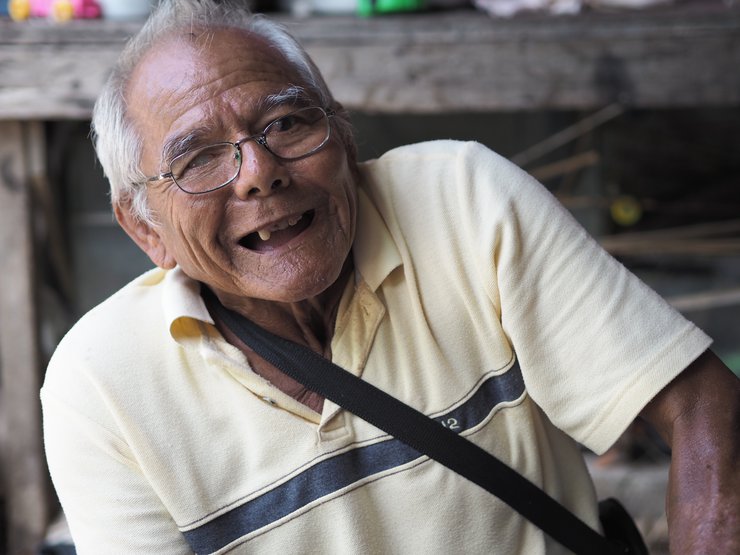
The kite maker
Once a year, kite makers and enthusiasts gather in Bangkok for a kite flying competition. The man who's teaching us to make our kites hasn't entered before, but he has been as a spectator, and to watchs on the winner. He's truly an expert in kites; he fashions them into all colours and sizes, and he produces up to 3,000 a year!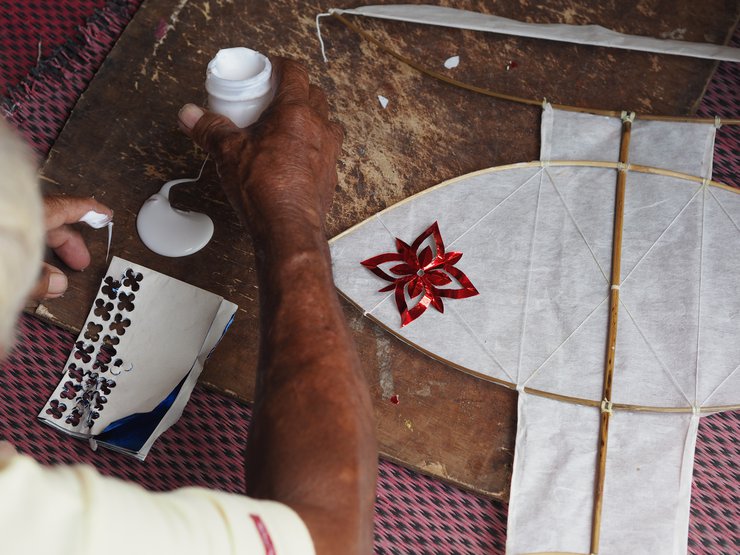
Creating foil patterns to decorate with
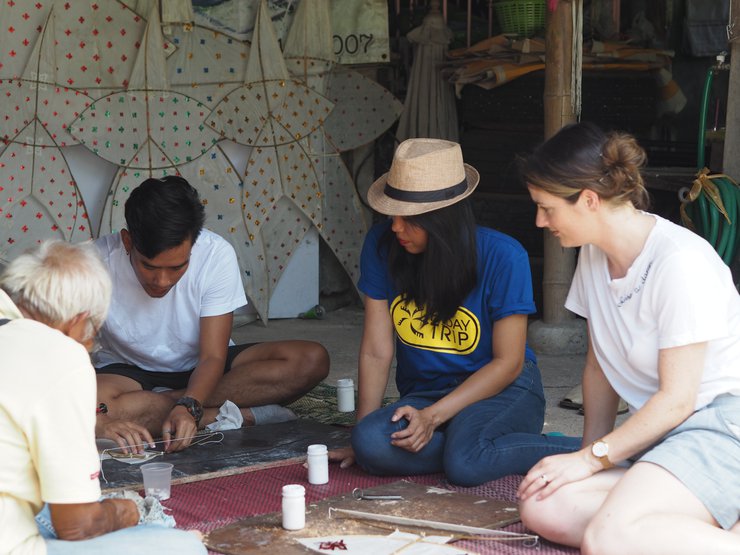
Learning from the master
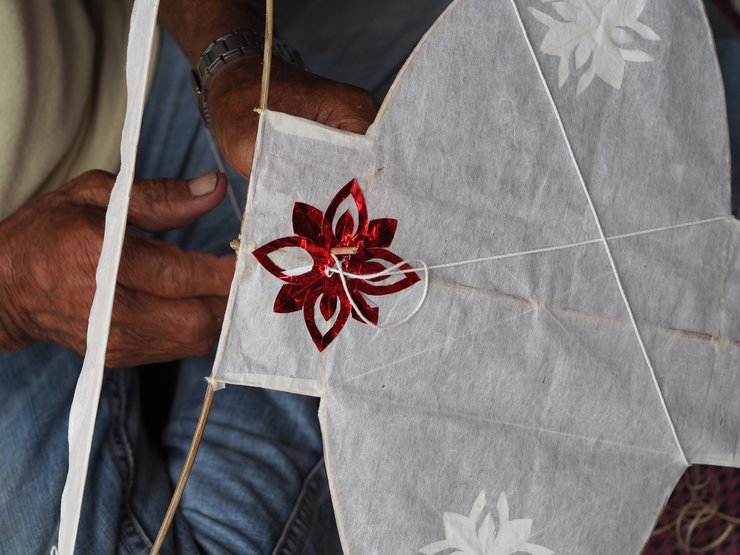
The kite being strung
We cut shapes from foil like paper snowflakes, and glue them onto our contraptions using just our fingers for brushes. Then a tail is deftly added, along with string to pull the kite along. And then it's time to put them to the test.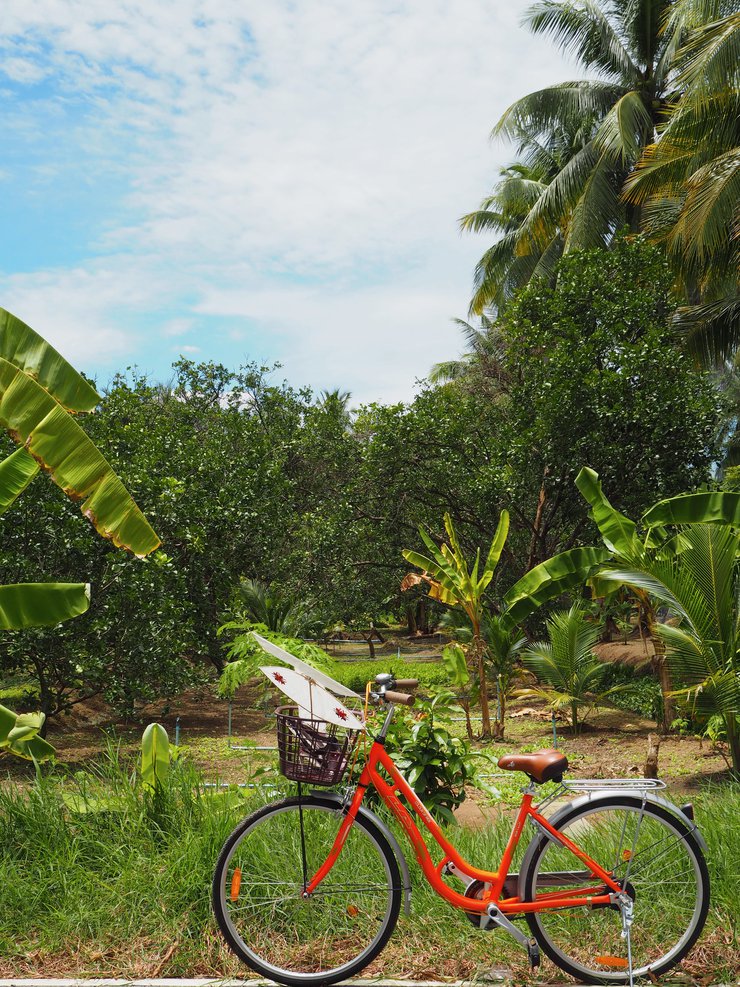
My bike in the orchards!
We cycle along a road flanked on both sides by lush greenery and bursts of brightly coloured flowers, and then we run. It's far too hot to run, and still we run, over and over, our kites flying in the wind behind us, triumphant yells drowning out any complaints about the heat. And then we have all the photos we need and I'm sweating more than I've ever sweated in my life. It's pouring off me. I think I must be at least 90% sweat. I think I might pass out.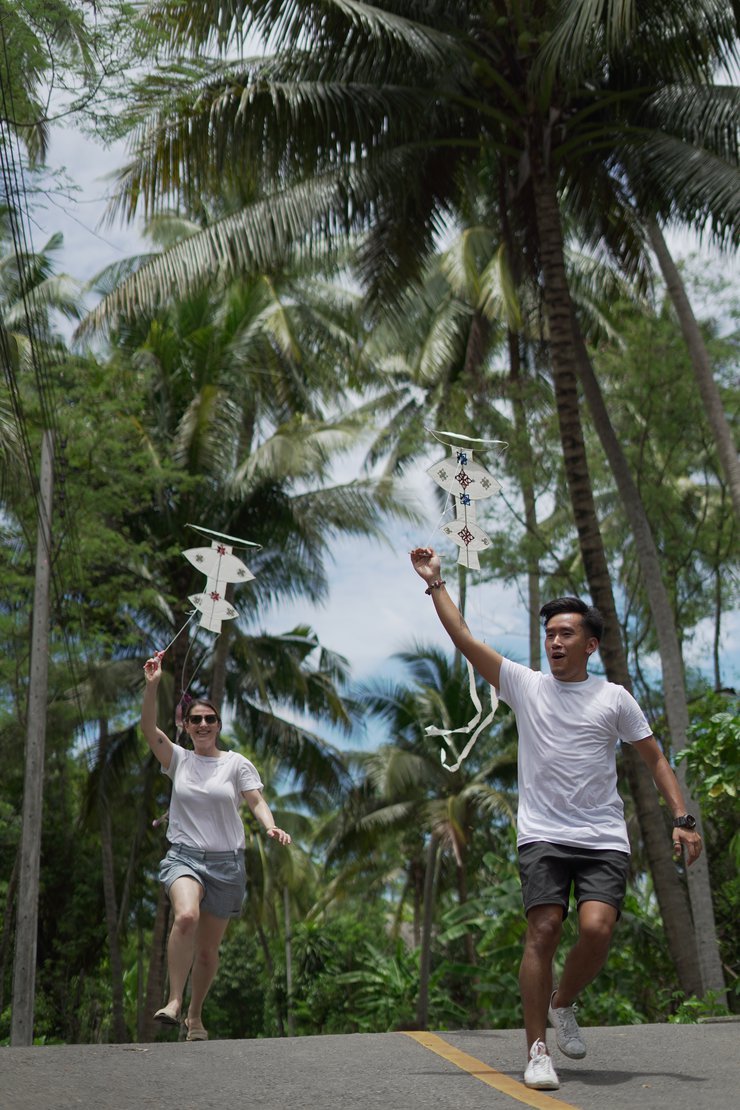
Testing our kites...they FLY!
We cycle back to the homestay and I immediately get into the air conditioning and have a blessedly cold shower.It's not a long break, but it's much needed. I have to change; my clothes are all absolutely dripping wet (gross, I know). I guess that's just life in a tropical climate...Next up, we drive to the Mae Khlong River and get onto a small, narrow boat. It takes us across the river and along a little way until we reach Wat Bang Kung Temple. It's busy. Bus loads of tourists pull up, and taking photos is hard. I suddenly realise that this is the first time I've encountered a crowd since Bangkok. It's quiet compared to many European attractions I've visited, but after four days of near solitude, it's something of a shock.
It's easy to see why they flock here, though. It has an important military history, which is highlighted by the many statues - and even planes - dotted around the grounds. The temple itself is something of a ruin, with banyan trees growing in, through, and around it. It looks like a scene from Indiana Jones or Tomb Raider.
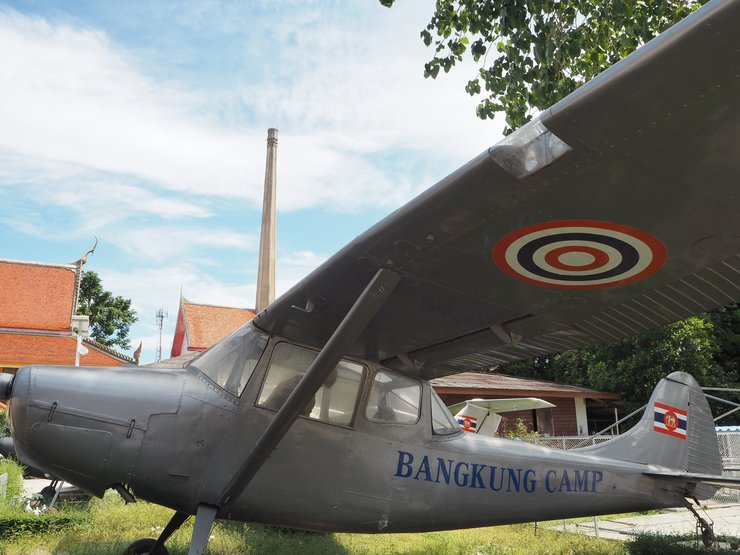
Military plane at Bang Kung Camp
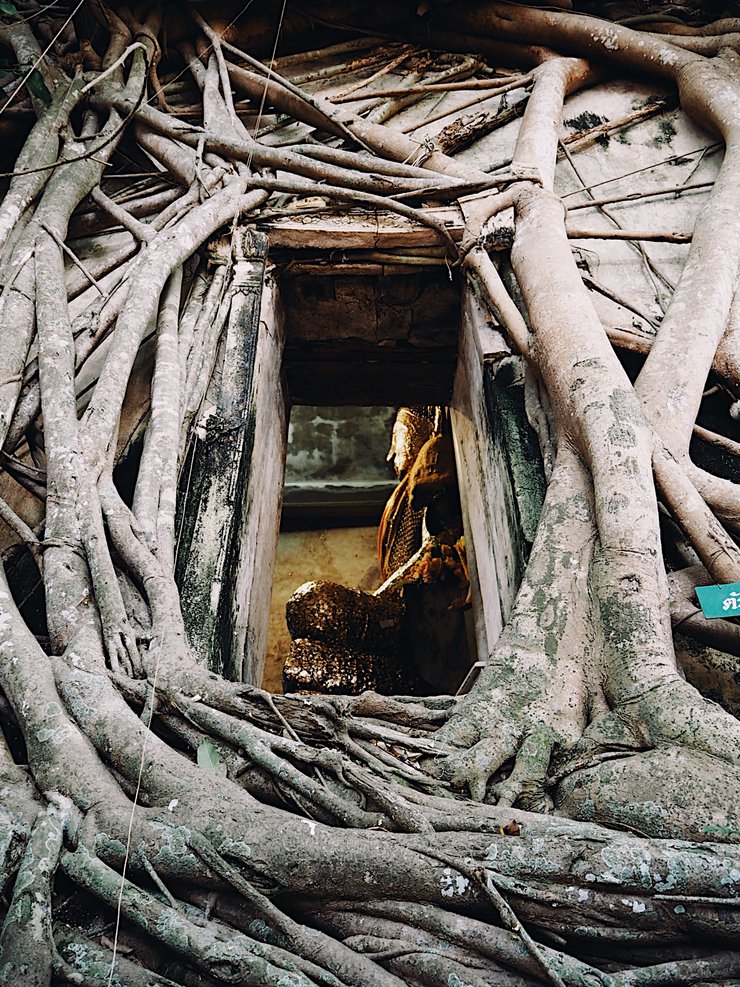
Wat Bang Kung Temple - the temple inside a banyan tree
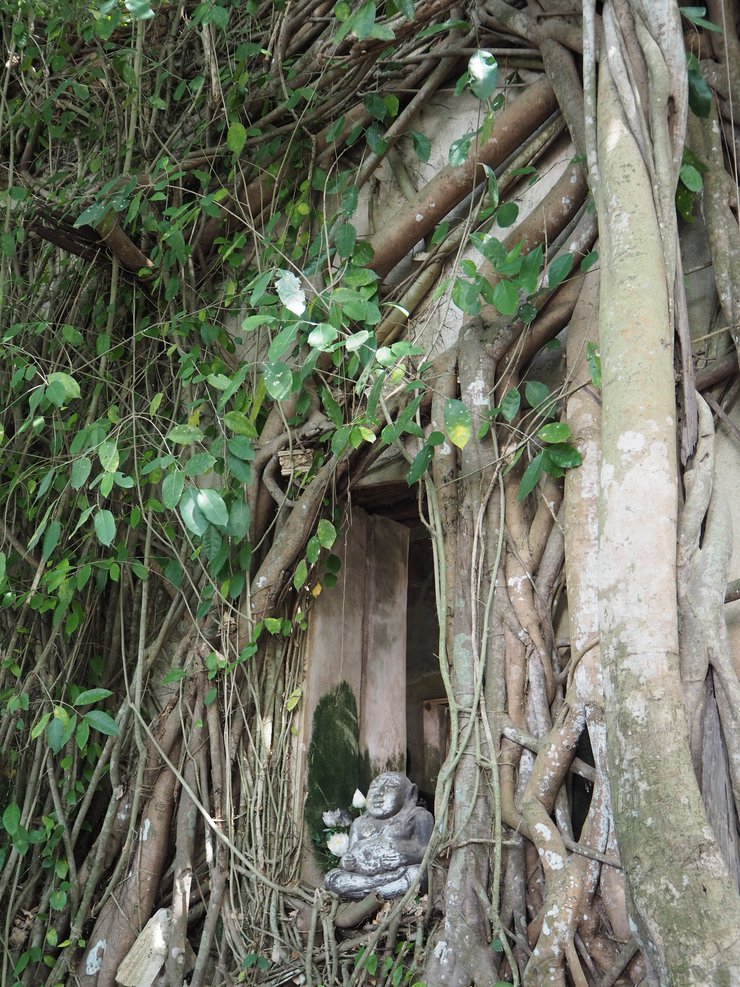
Wat Bang Kung Temple exterior
Through the windows, around the creeping vines and snaking branches, I catch a glimpse of gold. After removing my shoes, I step inside, the air cool, the crowds thick. The back wall is dominated by a giant golden Buddha, which visitors are queueing to touch. Then I walk around the a smaller building behind the temple. Inside is a mannequin with long, dark hair, and a whole load of traditional Thai dresses. Lucky explains to me that this was Princess Montrathip, who was something of a real life Mulan, going against her father's orders and dressing as a man to become a successful warrior. Now people bring offerings to her, as she's said to grant wishes, especially those around work and the military.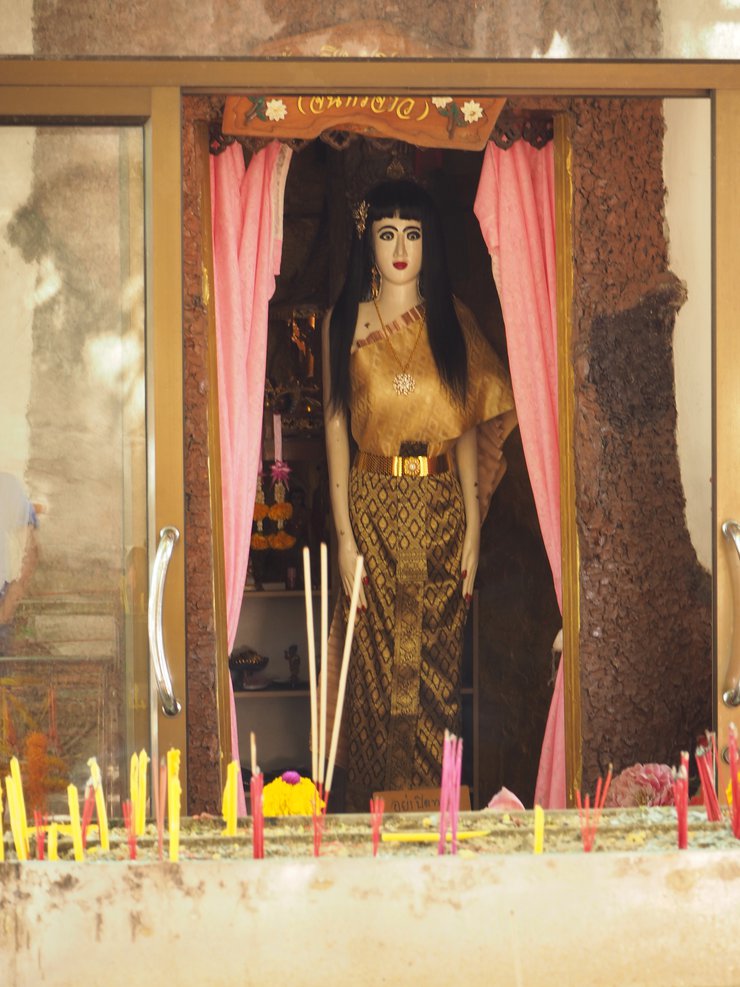
Princess Montrathip
Our next stop is another temple further down the river. This one is Wat Bang Khae Noi, which was originally built on a raft on the Mae Klong River. Now it has a permanent home, and it's famous for its teak floors and intricate interior carvings depicting the ten incarnations of Buddha.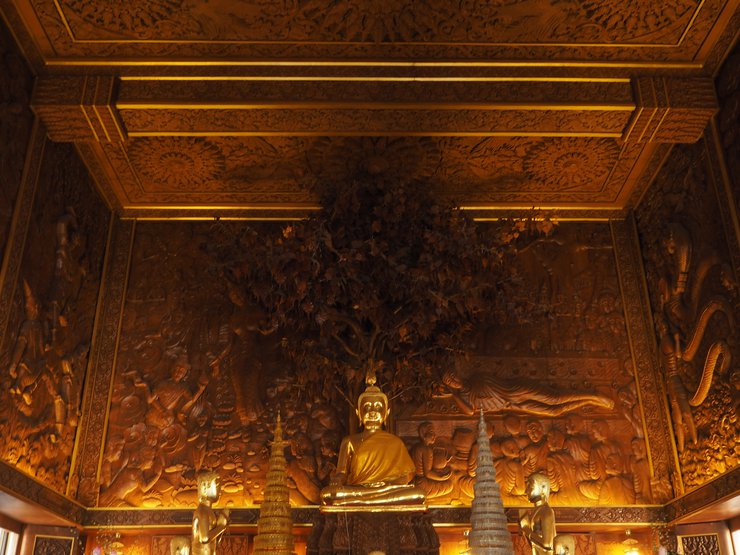
Teak interior at Wat Bang Khae Noi

Incredible teak carvings at Wat Bang Khae Noi
The most eye-catching feature is the tree that sits behind the giant Buddha statue, each leaf individually carved from teak. It's spectacular, and yet, strangely quiet. Seems like the tourists haven't discovered this one yet.
Exterior of Wat Bang Khae Noi
 The final temple we visit is Wat Phummarin, which was a more sprawling temple on large grounds along the river. We don't have long here, though - just enough time to peek inside a couple of the buildings, and then it's time to go.
The final temple we visit is Wat Phummarin, which was a more sprawling temple on large grounds along the river. We don't have long here, though - just enough time to peek inside a couple of the buildings, and then it's time to go.
We get on the boat again, bound for Amphawa Floating Market. This, too, is crowded, with throngs of people browsing and buying meals, snacks, fans, toys and clothes from vendors lining the river.
 As I watch the lazily moving water, I cry out in shock, pointing to the giant reptile that's casually swimming alongside a boat. It's enormous! It's a monitor lizard, a monstrous thing that dips under the boat and disappears at quickly as it arrived.
As I watch the lazily moving water, I cry out in shock, pointing to the giant reptile that's casually swimming alongside a boat. It's enormous! It's a monitor lizard, a monstrous thing that dips under the boat and disappears at quickly as it arrived.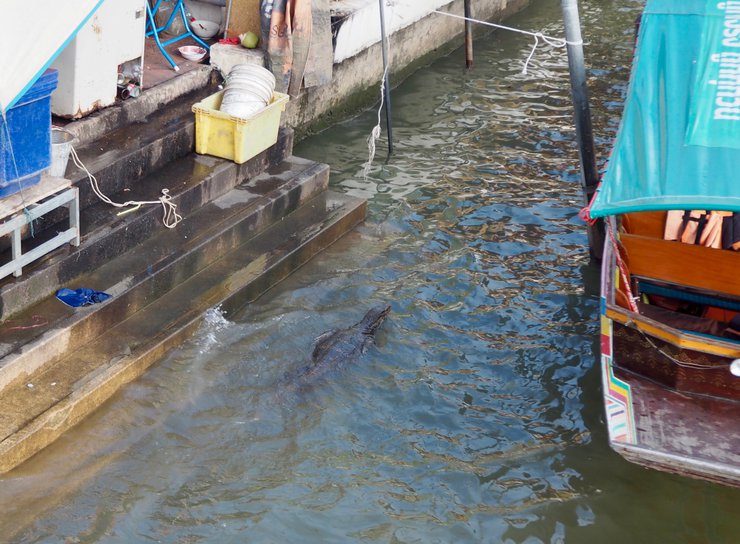 Although this market is lovely, it doesn't have the charm of Tha Kha, and it's incredibly crowded...trying to cross the footbridge across the canal is an interesting endeavour!We stop for dinner at a lovely shaded restaurant, and then we wait at the pier for our boat to arrive and pick us up one final time.
Although this market is lovely, it doesn't have the charm of Tha Kha, and it's incredibly crowded...trying to cross the footbridge across the canal is an interesting endeavour!We stop for dinner at a lovely shaded restaurant, and then we wait at the pier for our boat to arrive and pick us up one final time. 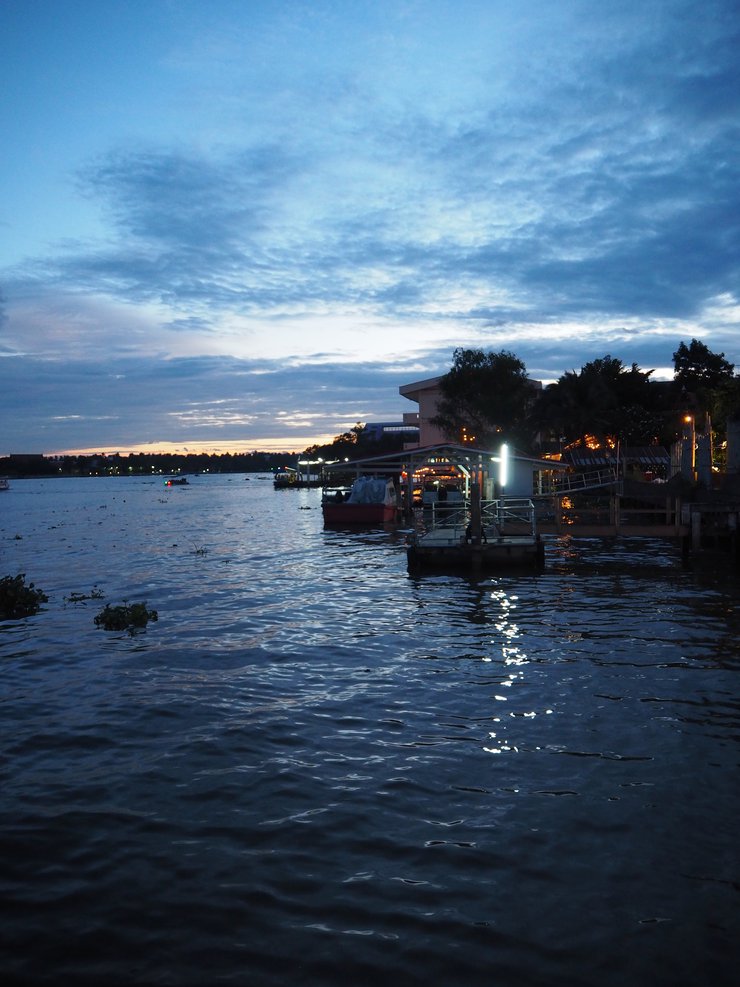 The sun has set, and the water is like glass again. We make our way through the waterways, until someone points at a tree beside us. It's alive with twinkling lights, as though it's Christmas at Hogwarts and the lights can twirl and dance. Fireflies.
The sun has set, and the water is like glass again. We make our way through the waterways, until someone points at a tree beside us. It's alive with twinkling lights, as though it's Christmas at Hogwarts and the lights can twirl and dance. Fireflies.  We watch, mesmerised, as the lights shimmer and flicker, and the water laps gently against the boat. And then it's time to drive back to Ban Bang Phlap and pack, ready for our departure tomorrow (how is it already time to leave?)But don't worry...there's still more to share before I get back to Bangkok, so stay tuned...
We watch, mesmerised, as the lights shimmer and flicker, and the water laps gently against the boat. And then it's time to drive back to Ban Bang Phlap and pack, ready for our departure tomorrow (how is it already time to leave?)But don't worry...there's still more to share before I get back to Bangkok, so stay tuned...
DAY SIX
This morning it's time to say goodbye to our hosts in Ban Bang Phlap. I find myself getting strangely emotional as I say my stuttered farewells. The kindness they've shown me - a stranger who doesn't speak their language and bumbles through their customs - has been overwhelming.

I'm presented with a box of coconut sugar - much neater than the ones we made - and Nong kindly tells me "Maybe we will see you again."
I reply "I hope so," and I truly do mean it. Only next time I come, I'll speak more Thai so I can do a better job of thanking them for their generous hospitality.

When I first arrived in Ban Bang Phlap, I had no idea what to expect. I hoped to see a glimpse of real life in a Thai village, but instead of that glimpse I was immersed in their life: touching moments of family love, meals, their stories, laughter, the wisdom they've accumulated over generations. I feel incredibly honoured to have witnessed such an authentic slice of Thai life and I've learned so much from my few days here.
I've learned about farming and sustainability. I've learned handicrafts and cooking. I've learned that there's more to connection than words. And more than anything else, I've learned what it means to welcome someone without reservation, to give without expectation, to be generous with smiles and laughter.
But the day isn't over yet, and there's more to learn and experience. We stop at King Rama II Memorial Park, and Lucky points out to women dressed in traditional Thai clothing. She asks if I want to dress up, and I don't hesitate before saying "of course!"
I choose a bright coral colour and the woman in the rental shop dresses me. My hips seem to confuse her a little, but soon I'm all wrapped up and being adorned with beautiful jewellery.

I feel so dainty and glamorous, and as I step outside with a parasol, I can't keep the smile off my face. We wander around the park, peering inside traditional Thai houses to see the tools they'd have once used in their day to day life, the way their homes were laid out (including a male and female room), and the fashion and beauty regimes of the past.



The gardens are immaculate and bursting with bright colours, and it's a perfect day, the sky blue with just a few wisps of cloud floating by overhead. I pose for photos, and try not to sweat too badly on the beautiful fabric.


When it's time to leave, I'm sad to fold up the gorgeous bright colours and hand them back, but I'm pleased to be able to take steps that are bigger than a few centimetres at a time!
We drive a little way along the highway until we reach the Salt Farm de Maeklong, a cafe and restaurant that looks out over the flat fields of a salt farm. Strangely, the cafe is Christmas themed, so there are carols playing and a snowman made from salt by the window.


Nam Wan, one of the owners, serves us the cafe's specialty: iced coffee made with salt. I'm hesitant to try it, but it's surprisingly tasty, and not very salty at all.
After a quick (but tasty) lunch we explore the salt flats - including an extremely Instagrammable swing and a foot spa area, where you can use the salt to give yourself a pedicure overlooking the flats.



It starts raining - heavily - so we stop taking photos and take shelter inside. The other owner, Eak, shows us his collection of different salts from around the world. He's travelled extensively, and has the photos to prove it - they hang from the walls of the cafe, showing stunning scenes from every corner of the globe.

And finally, it's time to say farewell to our camera crew. Nat and Aum have been with us since day one, directing videos and photos, making us do take after take, but always with a smile and a joke. At the start, I was shy around them, not knowing how to move beyond the language barrier, but by now I'm cracking jokes and so are they - some we get, others we just laugh at because we can tell a joke has been made. I've been throwing my camera at them all morning, getting them to take shots of me with my own camera for once, and they've happily obliged.

After saying goodbye, we get into the van and drive towards Bangkok. It's a surprisingly fast journey - it only takes an hour and a half or so, and before I know it I'm back in the SC Park hotel, where this all began, trying to wrap my head around the fact that I've graduated from the Thailand Village Academy, and it's all over.
But I know it's not really over.
Because the lessons I've learned, and the people I've met...they'll stay with me. I'm not going to be going home the same person as I was when I arrived, and for that I am so grateful.
I've fallen in love with this country. I've fallen in love with the people.
And, like I promised Nong when I waved goodbye to Ban Bang Phlap, I hope one day I'll be back.
Elle Croft
Wednesday, July 24, 2019 7:02 AM













